Entrepreneurship and Small Business Management Report
VerifiedAdded on 2023/06/17
|21
|6638
|192
AI Summary
This report covers different types of entrepreneurial ventures, their interrelation with entrepreneurship typologies, similarities and differences between entrepreneurial ventures, and the impact of micro and small business enterprises on the economy. It also explores the characteristics, skills, and traits of successful entrepreneurs and how background and experiences hinder or foster entrepreneurship.
Contribute Materials
Your contribution can guide someone’s learning journey. Share your
documents today.

Entrepreneurship
and Small
Business
management
and Small
Business
management
Secure Best Marks with AI Grader
Need help grading? Try our AI Grader for instant feedback on your assignments.
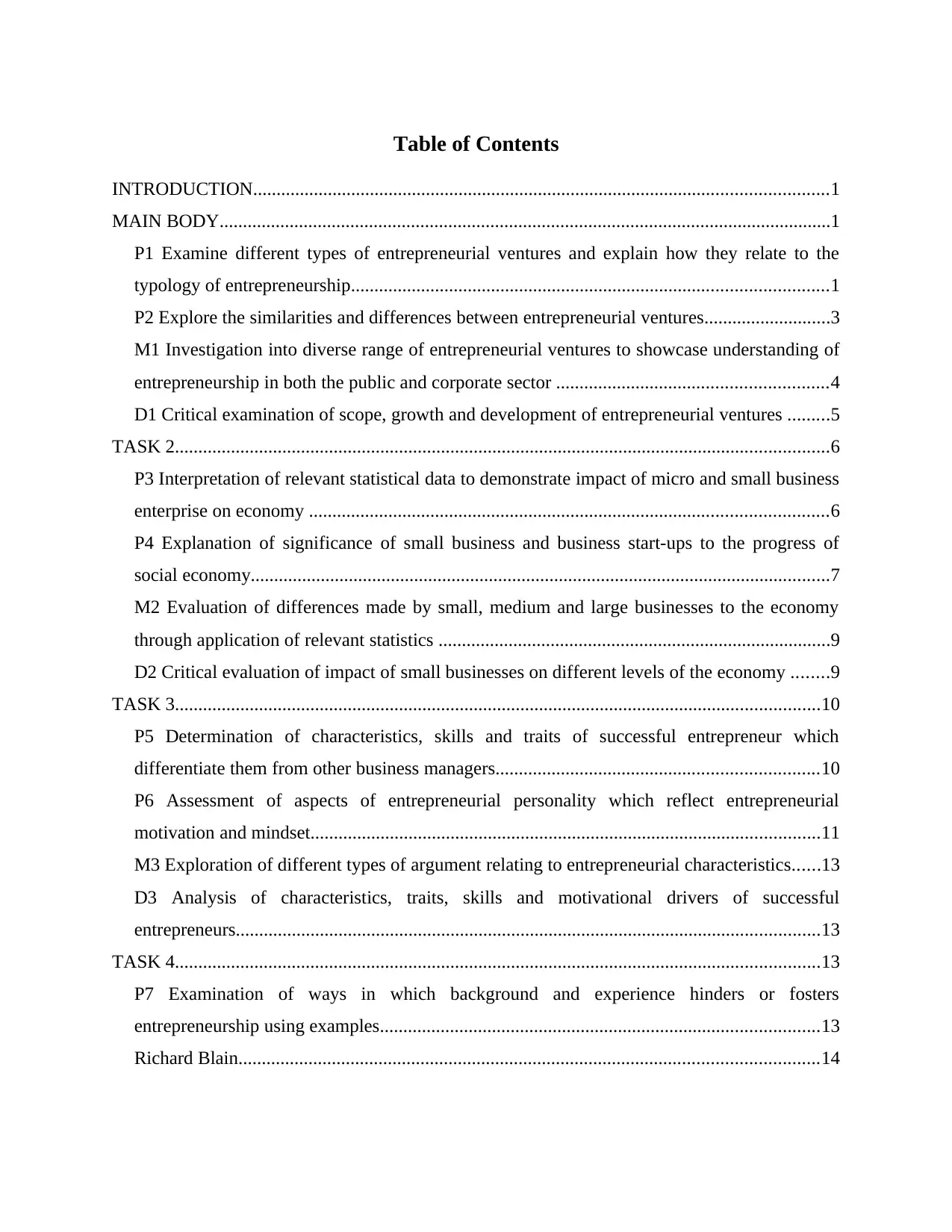
Table of Contents
INTRODUCTION...........................................................................................................................1
MAIN BODY...................................................................................................................................1
P1 Examine different types of entrepreneurial ventures and explain how they relate to the
typology of entrepreneurship......................................................................................................1
P2 Explore the similarities and differences between entrepreneurial ventures...........................3
M1 Investigation into diverse range of entrepreneurial ventures to showcase understanding of
entrepreneurship in both the public and corporate sector ..........................................................4
D1 Critical examination of scope, growth and development of entrepreneurial ventures .........5
TASK 2............................................................................................................................................6
P3 Interpretation of relevant statistical data to demonstrate impact of micro and small business
enterprise on economy ...............................................................................................................6
P4 Explanation of significance of small business and business start-ups to the progress of
social economy............................................................................................................................7
M2 Evaluation of differences made by small, medium and large businesses to the economy
through application of relevant statistics ....................................................................................9
D2 Critical evaluation of impact of small businesses on different levels of the economy ........9
TASK 3..........................................................................................................................................10
P5 Determination of characteristics, skills and traits of successful entrepreneur which
differentiate them from other business managers.....................................................................10
P6 Assessment of aspects of entrepreneurial personality which reflect entrepreneurial
motivation and mindset.............................................................................................................11
M3 Exploration of different types of argument relating to entrepreneurial characteristics......13
D3 Analysis of characteristics, traits, skills and motivational drivers of successful
entrepreneurs.............................................................................................................................13
TASK 4..........................................................................................................................................13
P7 Examination of ways in which background and experience hinders or fosters
entrepreneurship using examples..............................................................................................13
Richard Blain............................................................................................................................14
INTRODUCTION...........................................................................................................................1
MAIN BODY...................................................................................................................................1
P1 Examine different types of entrepreneurial ventures and explain how they relate to the
typology of entrepreneurship......................................................................................................1
P2 Explore the similarities and differences between entrepreneurial ventures...........................3
M1 Investigation into diverse range of entrepreneurial ventures to showcase understanding of
entrepreneurship in both the public and corporate sector ..........................................................4
D1 Critical examination of scope, growth and development of entrepreneurial ventures .........5
TASK 2............................................................................................................................................6
P3 Interpretation of relevant statistical data to demonstrate impact of micro and small business
enterprise on economy ...............................................................................................................6
P4 Explanation of significance of small business and business start-ups to the progress of
social economy............................................................................................................................7
M2 Evaluation of differences made by small, medium and large businesses to the economy
through application of relevant statistics ....................................................................................9
D2 Critical evaluation of impact of small businesses on different levels of the economy ........9
TASK 3..........................................................................................................................................10
P5 Determination of characteristics, skills and traits of successful entrepreneur which
differentiate them from other business managers.....................................................................10
P6 Assessment of aspects of entrepreneurial personality which reflect entrepreneurial
motivation and mindset.............................................................................................................11
M3 Exploration of different types of argument relating to entrepreneurial characteristics......13
D3 Analysis of characteristics, traits, skills and motivational drivers of successful
entrepreneurs.............................................................................................................................13
TASK 4..........................................................................................................................................13
P7 Examination of ways in which background and experience hinders or fosters
entrepreneurship using examples..............................................................................................13
Richard Blain............................................................................................................................14

M4 analysis of linkage between entrepreneurial characteristics and influence of personal
background................................................................................................................................14
D4 Critical analysis of background and experience influencing entrepreneurs........................15
CONCLUSION..............................................................................................................................16
REFERENCES..............................................................................................................................17
background................................................................................................................................14
D4 Critical analysis of background and experience influencing entrepreneurs........................15
CONCLUSION..............................................................................................................................16
REFERENCES..............................................................................................................................17
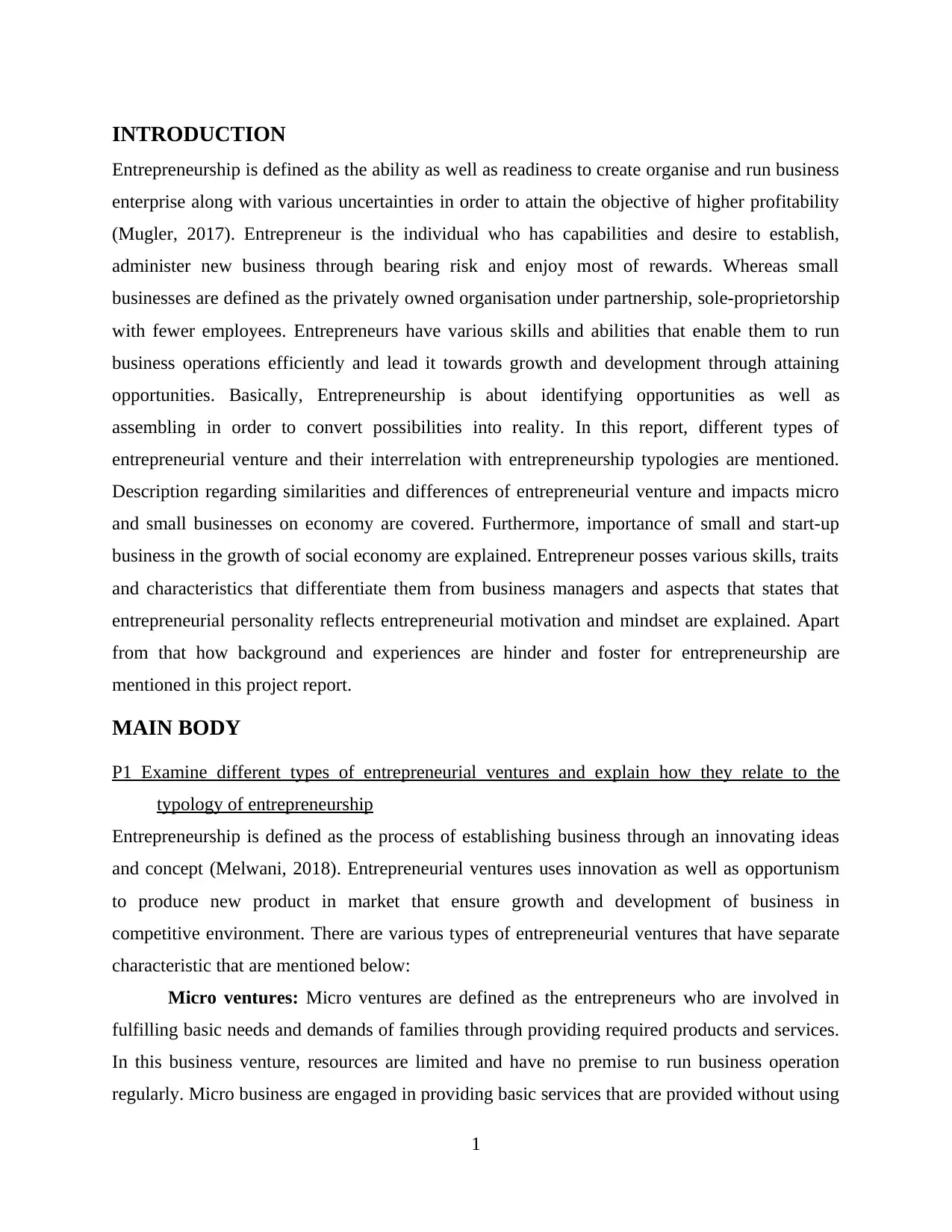
INTRODUCTION
Entrepreneurship is defined as the ability as well as readiness to create organise and run business
enterprise along with various uncertainties in order to attain the objective of higher profitability
(Mugler, 2017). Entrepreneur is the individual who has capabilities and desire to establish,
administer new business through bearing risk and enjoy most of rewards. Whereas small
businesses are defined as the privately owned organisation under partnership, sole-proprietorship
with fewer employees. Entrepreneurs have various skills and abilities that enable them to run
business operations efficiently and lead it towards growth and development through attaining
opportunities. Basically, Entrepreneurship is about identifying opportunities as well as
assembling in order to convert possibilities into reality. In this report, different types of
entrepreneurial venture and their interrelation with entrepreneurship typologies are mentioned.
Description regarding similarities and differences of entrepreneurial venture and impacts micro
and small businesses on economy are covered. Furthermore, importance of small and start-up
business in the growth of social economy are explained. Entrepreneur posses various skills, traits
and characteristics that differentiate them from business managers and aspects that states that
entrepreneurial personality reflects entrepreneurial motivation and mindset are explained. Apart
from that how background and experiences are hinder and foster for entrepreneurship are
mentioned in this project report.
MAIN BODY
P1 Examine different types of entrepreneurial ventures and explain how they relate to the
typology of entrepreneurship
Entrepreneurship is defined as the process of establishing business through an innovating ideas
and concept (Melwani, 2018). Entrepreneurial ventures uses innovation as well as opportunism
to produce new product in market that ensure growth and development of business in
competitive environment. There are various types of entrepreneurial ventures that have separate
characteristic that are mentioned below:
Micro ventures: Micro ventures are defined as the entrepreneurs who are involved in
fulfilling basic needs and demands of families through providing required products and services.
In this business venture, resources are limited and have no premise to run business operation
regularly. Micro business are engaged in providing basic services that are provided without using
1
Entrepreneurship is defined as the ability as well as readiness to create organise and run business
enterprise along with various uncertainties in order to attain the objective of higher profitability
(Mugler, 2017). Entrepreneur is the individual who has capabilities and desire to establish,
administer new business through bearing risk and enjoy most of rewards. Whereas small
businesses are defined as the privately owned organisation under partnership, sole-proprietorship
with fewer employees. Entrepreneurs have various skills and abilities that enable them to run
business operations efficiently and lead it towards growth and development through attaining
opportunities. Basically, Entrepreneurship is about identifying opportunities as well as
assembling in order to convert possibilities into reality. In this report, different types of
entrepreneurial venture and their interrelation with entrepreneurship typologies are mentioned.
Description regarding similarities and differences of entrepreneurial venture and impacts micro
and small businesses on economy are covered. Furthermore, importance of small and start-up
business in the growth of social economy are explained. Entrepreneur posses various skills, traits
and characteristics that differentiate them from business managers and aspects that states that
entrepreneurial personality reflects entrepreneurial motivation and mindset are explained. Apart
from that how background and experiences are hinder and foster for entrepreneurship are
mentioned in this project report.
MAIN BODY
P1 Examine different types of entrepreneurial ventures and explain how they relate to the
typology of entrepreneurship
Entrepreneurship is defined as the process of establishing business through an innovating ideas
and concept (Melwani, 2018). Entrepreneurial ventures uses innovation as well as opportunism
to produce new product in market that ensure growth and development of business in
competitive environment. There are various types of entrepreneurial ventures that have separate
characteristic that are mentioned below:
Micro ventures: Micro ventures are defined as the entrepreneurs who are involved in
fulfilling basic needs and demands of families through providing required products and services.
In this business venture, resources are limited and have no premise to run business operation
regularly. Micro business are engaged in providing basic services that are provided without using
1
Secure Best Marks with AI Grader
Need help grading? Try our AI Grader for instant feedback on your assignments.
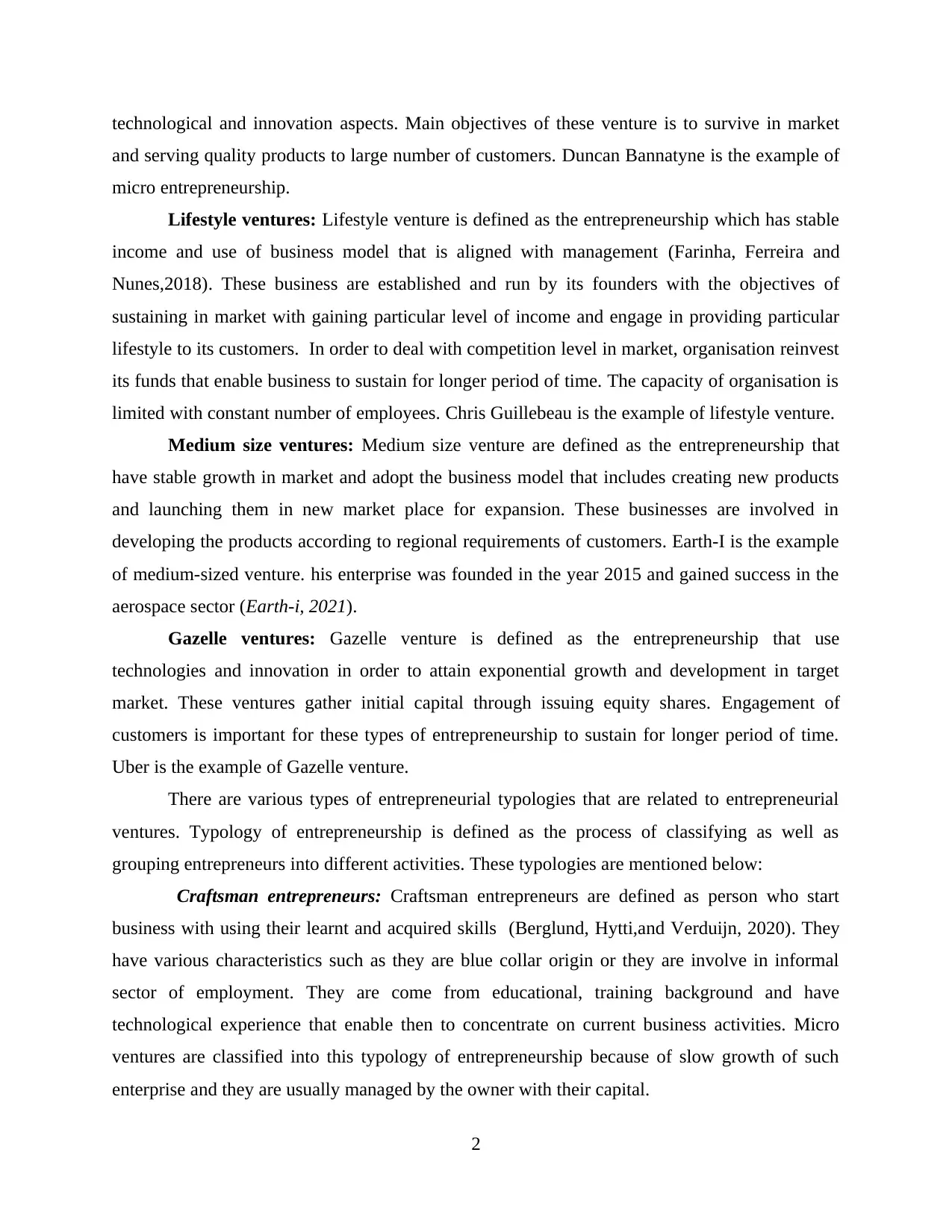
technological and innovation aspects. Main objectives of these venture is to survive in market
and serving quality products to large number of customers. Duncan Bannatyne is the example of
micro entrepreneurship.
Lifestyle ventures: Lifestyle venture is defined as the entrepreneurship which has stable
income and use of business model that is aligned with management (Farinha, Ferreira and
Nunes,2018). These business are established and run by its founders with the objectives of
sustaining in market with gaining particular level of income and engage in providing particular
lifestyle to its customers. In order to deal with competition level in market, organisation reinvest
its funds that enable business to sustain for longer period of time. The capacity of organisation is
limited with constant number of employees. Chris Guillebeau is the example of lifestyle venture.
Medium size ventures: Medium size venture are defined as the entrepreneurship that
have stable growth in market and adopt the business model that includes creating new products
and launching them in new market place for expansion. These businesses are involved in
developing the products according to regional requirements of customers. Earth-I is the example
of medium-sized venture. his enterprise was founded in the year 2015 and gained success in the
aerospace sector (Earth-i, 2021).
Gazelle ventures: Gazelle venture is defined as the entrepreneurship that use
technologies and innovation in order to attain exponential growth and development in target
market. These ventures gather initial capital through issuing equity shares. Engagement of
customers is important for these types of entrepreneurship to sustain for longer period of time.
Uber is the example of Gazelle venture.
There are various types of entrepreneurial typologies that are related to entrepreneurial
ventures. Typology of entrepreneurship is defined as the process of classifying as well as
grouping entrepreneurs into different activities. These typologies are mentioned below:
Craftsman entrepreneurs: Craftsman entrepreneurs are defined as person who start
business with using their learnt and acquired skills (Berglund, Hytti,and Verduijn, 2020). They
have various characteristics such as they are blue collar origin or they are involve in informal
sector of employment. They are come from educational, training background and have
technological experience that enable then to concentrate on current business activities. Micro
ventures are classified into this typology of entrepreneurship because of slow growth of such
enterprise and they are usually managed by the owner with their capital.
2
and serving quality products to large number of customers. Duncan Bannatyne is the example of
micro entrepreneurship.
Lifestyle ventures: Lifestyle venture is defined as the entrepreneurship which has stable
income and use of business model that is aligned with management (Farinha, Ferreira and
Nunes,2018). These business are established and run by its founders with the objectives of
sustaining in market with gaining particular level of income and engage in providing particular
lifestyle to its customers. In order to deal with competition level in market, organisation reinvest
its funds that enable business to sustain for longer period of time. The capacity of organisation is
limited with constant number of employees. Chris Guillebeau is the example of lifestyle venture.
Medium size ventures: Medium size venture are defined as the entrepreneurship that
have stable growth in market and adopt the business model that includes creating new products
and launching them in new market place for expansion. These businesses are involved in
developing the products according to regional requirements of customers. Earth-I is the example
of medium-sized venture. his enterprise was founded in the year 2015 and gained success in the
aerospace sector (Earth-i, 2021).
Gazelle ventures: Gazelle venture is defined as the entrepreneurship that use
technologies and innovation in order to attain exponential growth and development in target
market. These ventures gather initial capital through issuing equity shares. Engagement of
customers is important for these types of entrepreneurship to sustain for longer period of time.
Uber is the example of Gazelle venture.
There are various types of entrepreneurial typologies that are related to entrepreneurial
ventures. Typology of entrepreneurship is defined as the process of classifying as well as
grouping entrepreneurs into different activities. These typologies are mentioned below:
Craftsman entrepreneurs: Craftsman entrepreneurs are defined as person who start
business with using their learnt and acquired skills (Berglund, Hytti,and Verduijn, 2020). They
have various characteristics such as they are blue collar origin or they are involve in informal
sector of employment. They are come from educational, training background and have
technological experience that enable then to concentrate on current business activities. Micro
ventures are classified into this typology of entrepreneurship because of slow growth of such
enterprise and they are usually managed by the owner with their capital.
2
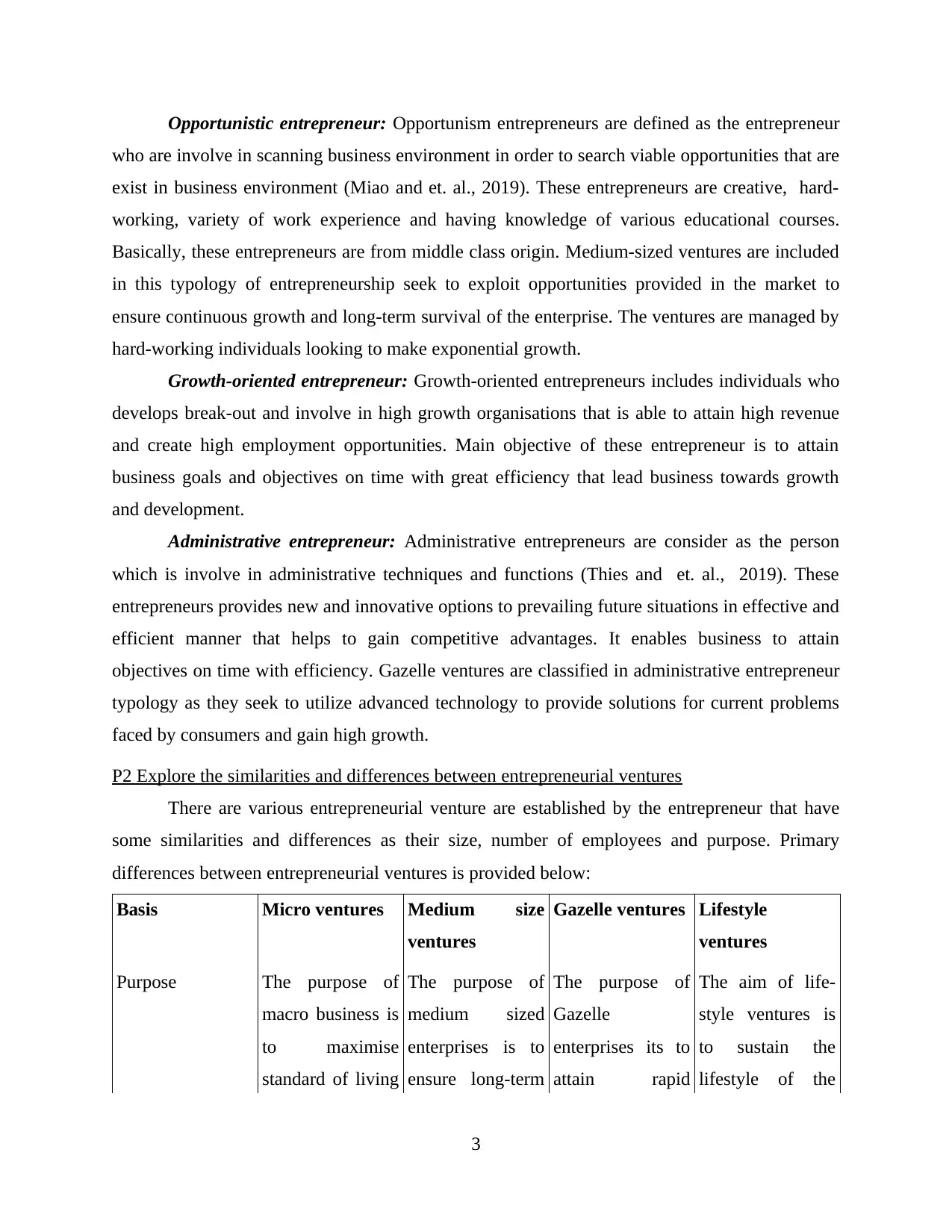
Opportunistic entrepreneur: Opportunism entrepreneurs are defined as the entrepreneur
who are involve in scanning business environment in order to search viable opportunities that are
exist in business environment (Miao and et. al., 2019). These entrepreneurs are creative, hard-
working, variety of work experience and having knowledge of various educational courses.
Basically, these entrepreneurs are from middle class origin. Medium-sized ventures are included
in this typology of entrepreneurship seek to exploit opportunities provided in the market to
ensure continuous growth and long-term survival of the enterprise. The ventures are managed by
hard-working individuals looking to make exponential growth.
Growth-oriented entrepreneur: Growth-oriented entrepreneurs includes individuals who
develops break-out and involve in high growth organisations that is able to attain high revenue
and create high employment opportunities. Main objective of these entrepreneur is to attain
business goals and objectives on time with great efficiency that lead business towards growth
and development.
Administrative entrepreneur: Administrative entrepreneurs are consider as the person
which is involve in administrative techniques and functions (Thies and et. al., 2019). These
entrepreneurs provides new and innovative options to prevailing future situations in effective and
efficient manner that helps to gain competitive advantages. It enables business to attain
objectives on time with efficiency. Gazelle ventures are classified in administrative entrepreneur
typology as they seek to utilize advanced technology to provide solutions for current problems
faced by consumers and gain high growth.
P2 Explore the similarities and differences between entrepreneurial ventures
There are various entrepreneurial venture are established by the entrepreneur that have
some similarities and differences as their size, number of employees and purpose. Primary
differences between entrepreneurial ventures is provided below:
Basis Micro ventures Medium size
ventures
Gazelle ventures Lifestyle
ventures
Purpose The purpose of
macro business is
to maximise
standard of living
The purpose of
medium sized
enterprises is to
ensure long-term
The purpose of
Gazelle
enterprises its to
attain rapid
The aim of life-
style ventures is
to sustain the
lifestyle of the
3
who are involve in scanning business environment in order to search viable opportunities that are
exist in business environment (Miao and et. al., 2019). These entrepreneurs are creative, hard-
working, variety of work experience and having knowledge of various educational courses.
Basically, these entrepreneurs are from middle class origin. Medium-sized ventures are included
in this typology of entrepreneurship seek to exploit opportunities provided in the market to
ensure continuous growth and long-term survival of the enterprise. The ventures are managed by
hard-working individuals looking to make exponential growth.
Growth-oriented entrepreneur: Growth-oriented entrepreneurs includes individuals who
develops break-out and involve in high growth organisations that is able to attain high revenue
and create high employment opportunities. Main objective of these entrepreneur is to attain
business goals and objectives on time with great efficiency that lead business towards growth
and development.
Administrative entrepreneur: Administrative entrepreneurs are consider as the person
which is involve in administrative techniques and functions (Thies and et. al., 2019). These
entrepreneurs provides new and innovative options to prevailing future situations in effective and
efficient manner that helps to gain competitive advantages. It enables business to attain
objectives on time with efficiency. Gazelle ventures are classified in administrative entrepreneur
typology as they seek to utilize advanced technology to provide solutions for current problems
faced by consumers and gain high growth.
P2 Explore the similarities and differences between entrepreneurial ventures
There are various entrepreneurial venture are established by the entrepreneur that have
some similarities and differences as their size, number of employees and purpose. Primary
differences between entrepreneurial ventures is provided below:
Basis Micro ventures Medium size
ventures
Gazelle ventures Lifestyle
ventures
Purpose The purpose of
macro business is
to maximise
standard of living
The purpose of
medium sized
enterprises is to
ensure long-term
The purpose of
Gazelle
enterprises its to
attain rapid
The aim of life-
style ventures is
to sustain the
lifestyle of the
3
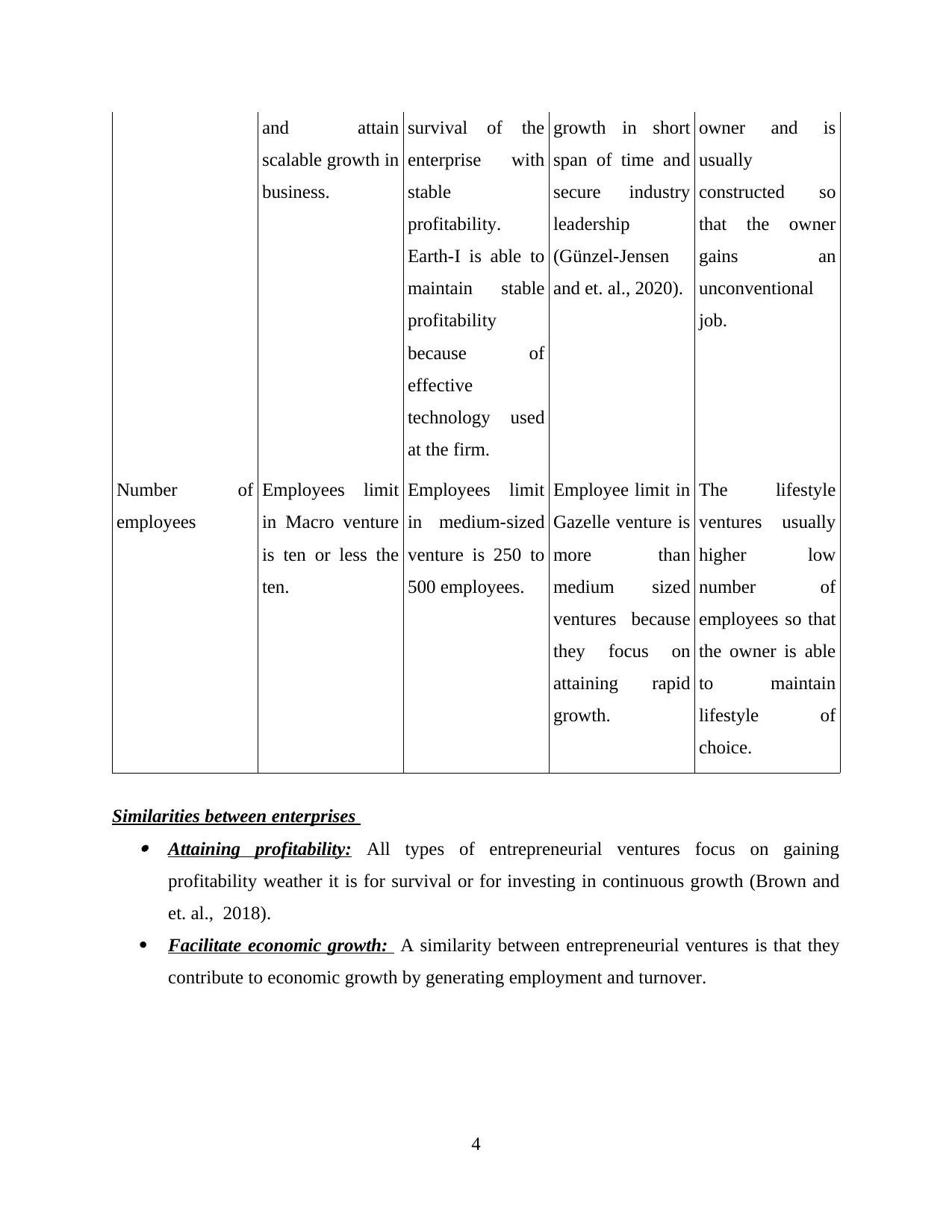
and attain
scalable growth in
business.
survival of the
enterprise with
stable
profitability.
Earth-I is able to
maintain stable
profitability
because of
effective
technology used
at the firm.
growth in short
span of time and
secure industry
leadership
(Günzel-Jensen
and et. al., 2020).
owner and is
usually
constructed so
that the owner
gains an
unconventional
job.
Number of
employees
Employees limit
in Macro venture
is ten or less the
ten.
Employees limit
in medium-sized
venture is 250 to
500 employees.
Employee limit in
Gazelle venture is
more than
medium sized
ventures because
they focus on
attaining rapid
growth.
The lifestyle
ventures usually
higher low
number of
employees so that
the owner is able
to maintain
lifestyle of
choice.
Similarities between enterprises Attaining profitability: All types of entrepreneurial ventures focus on gaining
profitability weather it is for survival or for investing in continuous growth (Brown and
et. al., 2018).
Facilitate economic growth: A similarity between entrepreneurial ventures is that they
contribute to economic growth by generating employment and turnover.
4
scalable growth in
business.
survival of the
enterprise with
stable
profitability.
Earth-I is able to
maintain stable
profitability
because of
effective
technology used
at the firm.
growth in short
span of time and
secure industry
leadership
(Günzel-Jensen
and et. al., 2020).
owner and is
usually
constructed so
that the owner
gains an
unconventional
job.
Number of
employees
Employees limit
in Macro venture
is ten or less the
ten.
Employees limit
in medium-sized
venture is 250 to
500 employees.
Employee limit in
Gazelle venture is
more than
medium sized
ventures because
they focus on
attaining rapid
growth.
The lifestyle
ventures usually
higher low
number of
employees so that
the owner is able
to maintain
lifestyle of
choice.
Similarities between enterprises Attaining profitability: All types of entrepreneurial ventures focus on gaining
profitability weather it is for survival or for investing in continuous growth (Brown and
et. al., 2018).
Facilitate economic growth: A similarity between entrepreneurial ventures is that they
contribute to economic growth by generating employment and turnover.
4
Paraphrase This Document
Need a fresh take? Get an instant paraphrase of this document with our AI Paraphraser
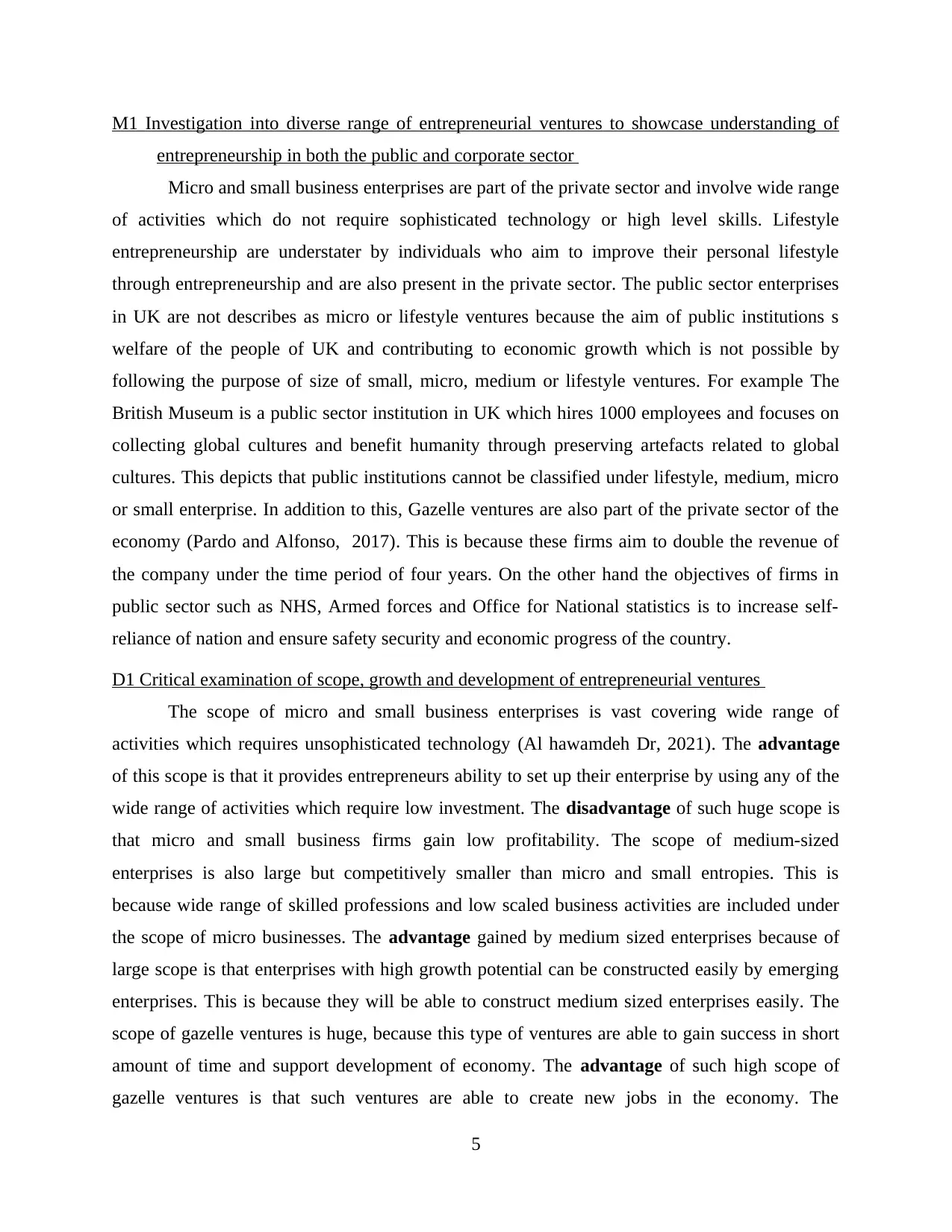
M1 Investigation into diverse range of entrepreneurial ventures to showcase understanding of
entrepreneurship in both the public and corporate sector
Micro and small business enterprises are part of the private sector and involve wide range
of activities which do not require sophisticated technology or high level skills. Lifestyle
entrepreneurship are understater by individuals who aim to improve their personal lifestyle
through entrepreneurship and are also present in the private sector. The public sector enterprises
in UK are not describes as micro or lifestyle ventures because the aim of public institutions s
welfare of the people of UK and contributing to economic growth which is not possible by
following the purpose of size of small, micro, medium or lifestyle ventures. For example The
British Museum is a public sector institution in UK which hires 1000 employees and focuses on
collecting global cultures and benefit humanity through preserving artefacts related to global
cultures. This depicts that public institutions cannot be classified under lifestyle, medium, micro
or small enterprise. In addition to this, Gazelle ventures are also part of the private sector of the
economy (Pardo and Alfonso, 2017). This is because these firms aim to double the revenue of
the company under the time period of four years. On the other hand the objectives of firms in
public sector such as NHS, Armed forces and Office for National statistics is to increase self-
reliance of nation and ensure safety security and economic progress of the country.
D1 Critical examination of scope, growth and development of entrepreneurial ventures
The scope of micro and small business enterprises is vast covering wide range of
activities which requires unsophisticated technology (Al hawamdeh Dr, 2021). The advantage
of this scope is that it provides entrepreneurs ability to set up their enterprise by using any of the
wide range of activities which require low investment. The disadvantage of such huge scope is
that micro and small business firms gain low profitability. The scope of medium-sized
enterprises is also large but competitively smaller than micro and small entropies. This is
because wide range of skilled professions and low scaled business activities are included under
the scope of micro businesses. The advantage gained by medium sized enterprises because of
large scope is that enterprises with high growth potential can be constructed easily by emerging
enterprises. This is because they will be able to construct medium sized enterprises easily. The
scope of gazelle ventures is huge, because this type of ventures are able to gain success in short
amount of time and support development of economy. The advantage of such high scope of
gazelle ventures is that such ventures are able to create new jobs in the economy. The
5
entrepreneurship in both the public and corporate sector
Micro and small business enterprises are part of the private sector and involve wide range
of activities which do not require sophisticated technology or high level skills. Lifestyle
entrepreneurship are understater by individuals who aim to improve their personal lifestyle
through entrepreneurship and are also present in the private sector. The public sector enterprises
in UK are not describes as micro or lifestyle ventures because the aim of public institutions s
welfare of the people of UK and contributing to economic growth which is not possible by
following the purpose of size of small, micro, medium or lifestyle ventures. For example The
British Museum is a public sector institution in UK which hires 1000 employees and focuses on
collecting global cultures and benefit humanity through preserving artefacts related to global
cultures. This depicts that public institutions cannot be classified under lifestyle, medium, micro
or small enterprise. In addition to this, Gazelle ventures are also part of the private sector of the
economy (Pardo and Alfonso, 2017). This is because these firms aim to double the revenue of
the company under the time period of four years. On the other hand the objectives of firms in
public sector such as NHS, Armed forces and Office for National statistics is to increase self-
reliance of nation and ensure safety security and economic progress of the country.
D1 Critical examination of scope, growth and development of entrepreneurial ventures
The scope of micro and small business enterprises is vast covering wide range of
activities which requires unsophisticated technology (Al hawamdeh Dr, 2021). The advantage
of this scope is that it provides entrepreneurs ability to set up their enterprise by using any of the
wide range of activities which require low investment. The disadvantage of such huge scope is
that micro and small business firms gain low profitability. The scope of medium-sized
enterprises is also large but competitively smaller than micro and small entropies. This is
because wide range of skilled professions and low scaled business activities are included under
the scope of micro businesses. The advantage gained by medium sized enterprises because of
large scope is that enterprises with high growth potential can be constructed easily by emerging
enterprises. This is because they will be able to construct medium sized enterprises easily. The
scope of gazelle ventures is huge, because this type of ventures are able to gain success in short
amount of time and support development of economy. The advantage of such high scope of
gazelle ventures is that such ventures are able to create new jobs in the economy. The
5
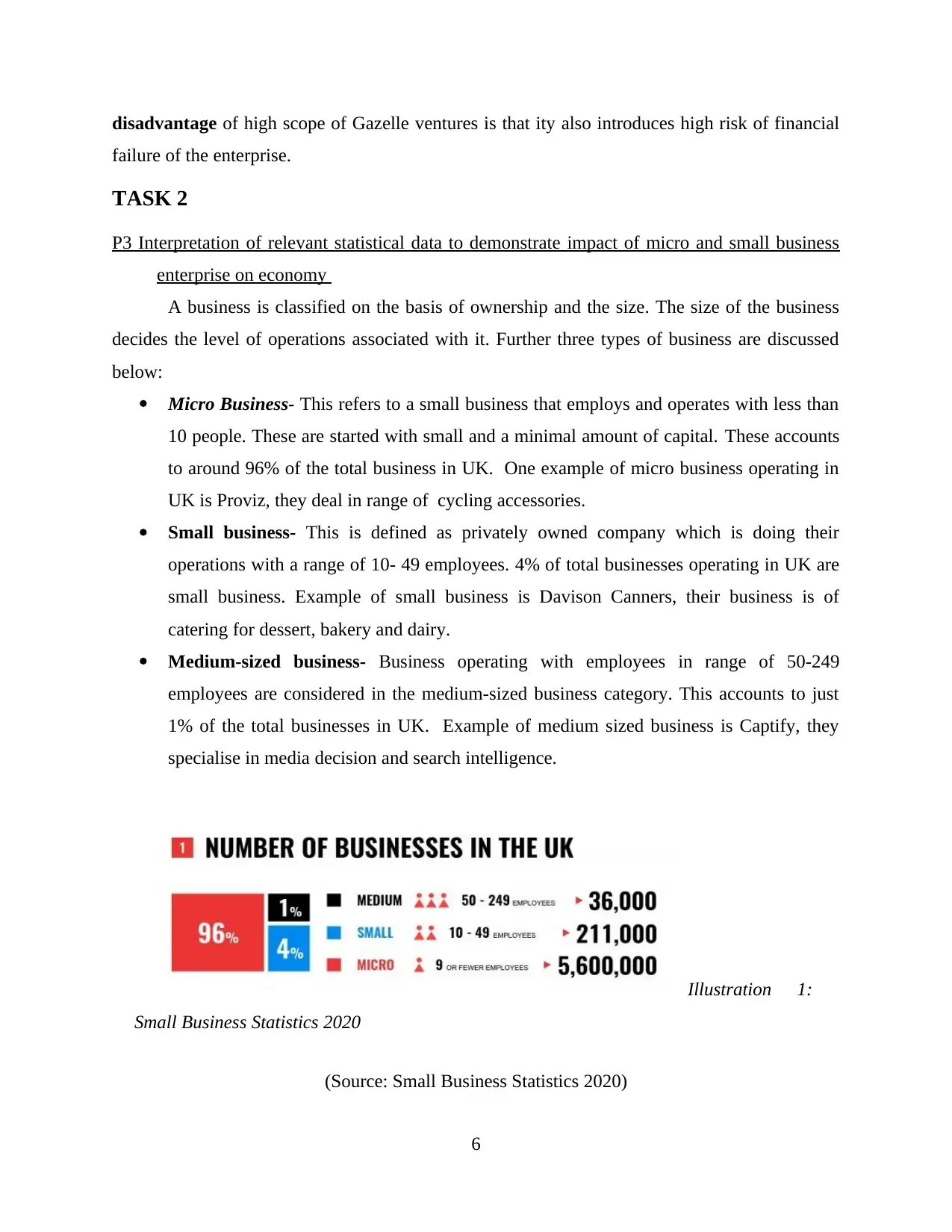
disadvantage of high scope of Gazelle ventures is that ity also introduces high risk of financial
failure of the enterprise.
TASK 2
P3 Interpretation of relevant statistical data to demonstrate impact of micro and small business
enterprise on economy
A business is classified on the basis of ownership and the size. The size of the business
decides the level of operations associated with it. Further three types of business are discussed
below:
Micro Business- This refers to a small business that employs and operates with less than
10 people. These are started with small and a minimal amount of capital. These accounts
to around 96% of the total business in UK. One example of micro business operating in
UK is Proviz, they deal in range of cycling accessories.
Small business- This is defined as privately owned company which is doing their
operations with a range of 10- 49 employees. 4% of total businesses operating in UK are
small business. Example of small business is Davison Canners, their business is of
catering for dessert, bakery and dairy.
Medium-sized business- Business operating with employees in range of 50-249
employees are considered in the medium-sized business category. This accounts to just
1% of the total businesses in UK. Example of medium sized business is Captify, they
specialise in media decision and search intelligence.
(Source: Small Business Statistics 2020)
6
Illustration 1:
Small Business Statistics 2020
failure of the enterprise.
TASK 2
P3 Interpretation of relevant statistical data to demonstrate impact of micro and small business
enterprise on economy
A business is classified on the basis of ownership and the size. The size of the business
decides the level of operations associated with it. Further three types of business are discussed
below:
Micro Business- This refers to a small business that employs and operates with less than
10 people. These are started with small and a minimal amount of capital. These accounts
to around 96% of the total business in UK. One example of micro business operating in
UK is Proviz, they deal in range of cycling accessories.
Small business- This is defined as privately owned company which is doing their
operations with a range of 10- 49 employees. 4% of total businesses operating in UK are
small business. Example of small business is Davison Canners, their business is of
catering for dessert, bakery and dairy.
Medium-sized business- Business operating with employees in range of 50-249
employees are considered in the medium-sized business category. This accounts to just
1% of the total businesses in UK. Example of medium sized business is Captify, they
specialise in media decision and search intelligence.
(Source: Small Business Statistics 2020)
6
Illustration 1:
Small Business Statistics 2020
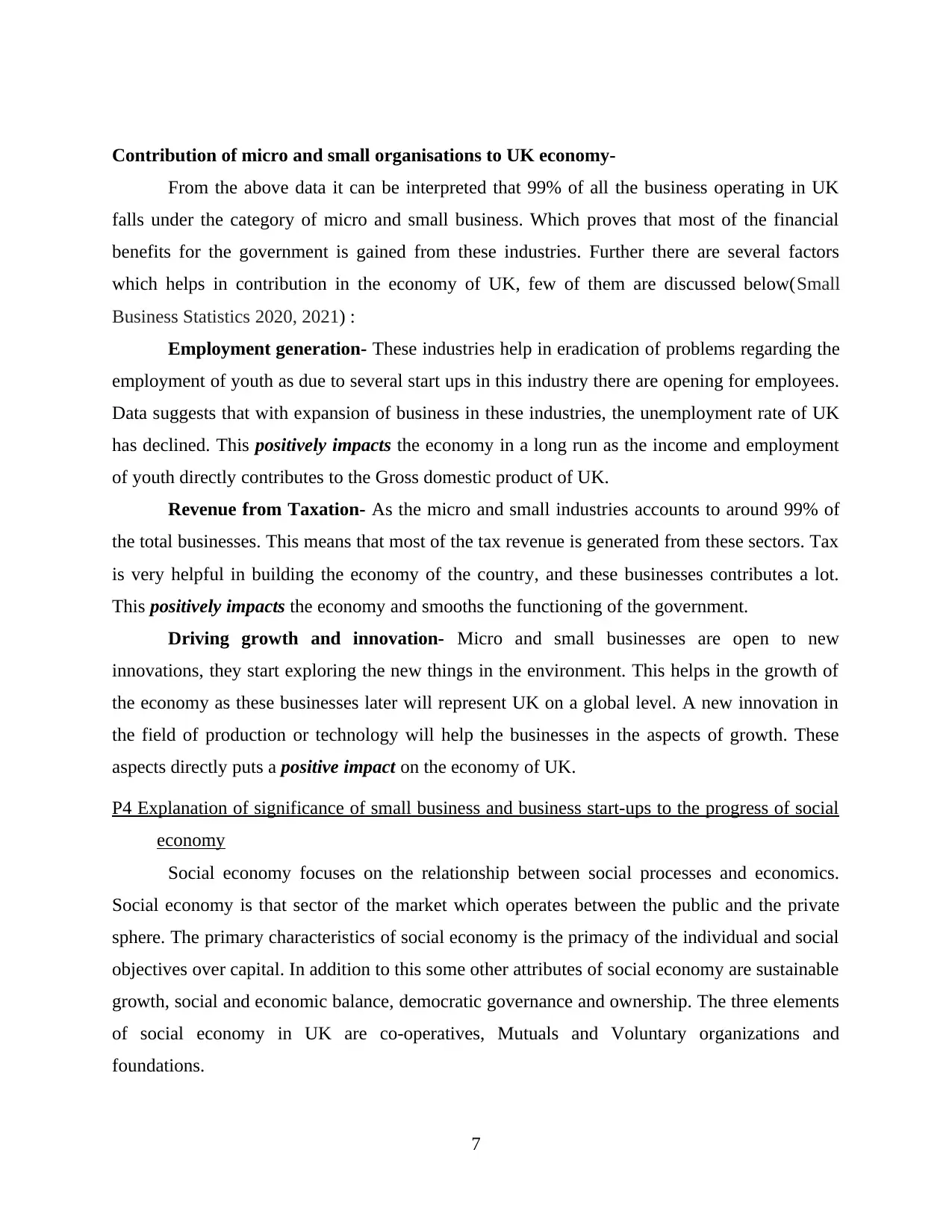
Contribution of micro and small organisations to UK economy-
From the above data it can be interpreted that 99% of all the business operating in UK
falls under the category of micro and small business. Which proves that most of the financial
benefits for the government is gained from these industries. Further there are several factors
which helps in contribution in the economy of UK, few of them are discussed below(Small
Business Statistics 2020, 2021) :
Employment generation- These industries help in eradication of problems regarding the
employment of youth as due to several start ups in this industry there are opening for employees.
Data suggests that with expansion of business in these industries, the unemployment rate of UK
has declined. This positively impacts the economy in a long run as the income and employment
of youth directly contributes to the Gross domestic product of UK.
Revenue from Taxation- As the micro and small industries accounts to around 99% of
the total businesses. This means that most of the tax revenue is generated from these sectors. Tax
is very helpful in building the economy of the country, and these businesses contributes a lot.
This positively impacts the economy and smooths the functioning of the government.
Driving growth and innovation- Micro and small businesses are open to new
innovations, they start exploring the new things in the environment. This helps in the growth of
the economy as these businesses later will represent UK on a global level. A new innovation in
the field of production or technology will help the businesses in the aspects of growth. These
aspects directly puts a positive impact on the economy of UK.
P4 Explanation of significance of small business and business start-ups to the progress of social
economy
Social economy focuses on the relationship between social processes and economics.
Social economy is that sector of the market which operates between the public and the private
sphere. The primary characteristics of social economy is the primacy of the individual and social
objectives over capital. In addition to this some other attributes of social economy are sustainable
growth, social and economic balance, democratic governance and ownership. The three elements
of social economy in UK are co-operatives, Mutuals and Voluntary organizations and
foundations.
7
From the above data it can be interpreted that 99% of all the business operating in UK
falls under the category of micro and small business. Which proves that most of the financial
benefits for the government is gained from these industries. Further there are several factors
which helps in contribution in the economy of UK, few of them are discussed below(Small
Business Statistics 2020, 2021) :
Employment generation- These industries help in eradication of problems regarding the
employment of youth as due to several start ups in this industry there are opening for employees.
Data suggests that with expansion of business in these industries, the unemployment rate of UK
has declined. This positively impacts the economy in a long run as the income and employment
of youth directly contributes to the Gross domestic product of UK.
Revenue from Taxation- As the micro and small industries accounts to around 99% of
the total businesses. This means that most of the tax revenue is generated from these sectors. Tax
is very helpful in building the economy of the country, and these businesses contributes a lot.
This positively impacts the economy and smooths the functioning of the government.
Driving growth and innovation- Micro and small businesses are open to new
innovations, they start exploring the new things in the environment. This helps in the growth of
the economy as these businesses later will represent UK on a global level. A new innovation in
the field of production or technology will help the businesses in the aspects of growth. These
aspects directly puts a positive impact on the economy of UK.
P4 Explanation of significance of small business and business start-ups to the progress of social
economy
Social economy focuses on the relationship between social processes and economics.
Social economy is that sector of the market which operates between the public and the private
sphere. The primary characteristics of social economy is the primacy of the individual and social
objectives over capital. In addition to this some other attributes of social economy are sustainable
growth, social and economic balance, democratic governance and ownership. The three elements
of social economy in UK are co-operatives, Mutuals and Voluntary organizations and
foundations.
7
Secure Best Marks with AI Grader
Need help grading? Try our AI Grader for instant feedback on your assignments.
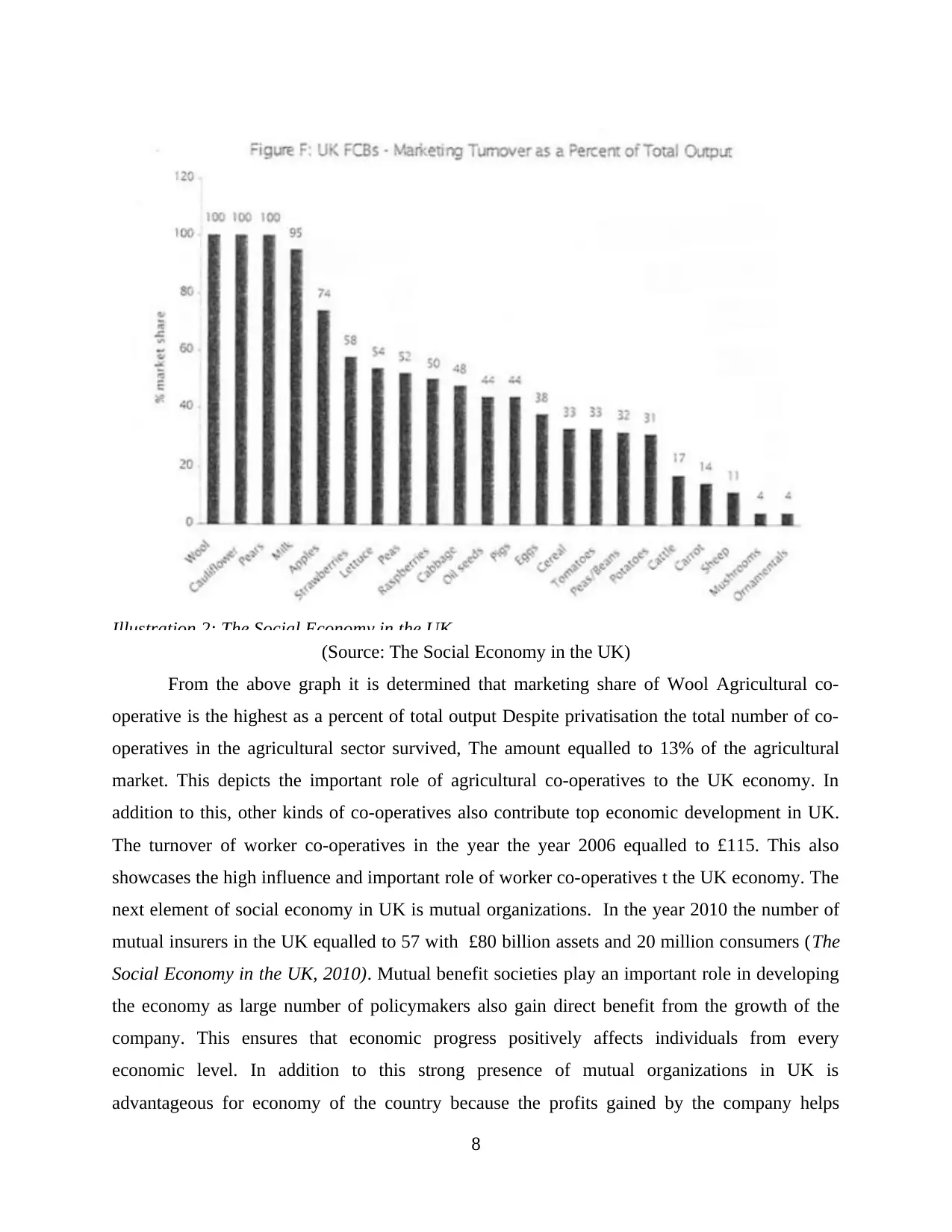
(Source: The Social Economy in the UK)
From the above graph it is determined that marketing share of Wool Agricultural co-
operative is the highest as a percent of total output Despite privatisation the total number of co-
operatives in the agricultural sector survived, The amount equalled to 13% of the agricultural
market. This depicts the important role of agricultural co-operatives to the UK economy. In
addition to this, other kinds of co-operatives also contribute top economic development in UK.
The turnover of worker co-operatives in the year the year 2006 equalled to £115. This also
showcases the high influence and important role of worker co-operatives t the UK economy. The
next element of social economy in UK is mutual organizations. In the year 2010 the number of
mutual insurers in the UK equalled to 57 with £80 billion assets and 20 million consumers (The
Social Economy in the UK, 2010). Mutual benefit societies play an important role in developing
the economy as large number of policymakers also gain direct benefit from the growth of the
company. This ensures that economic progress positively affects individuals from every
economic level. In addition to this strong presence of mutual organizations in UK is
advantageous for economy of the country because the profits gained by the company helps
8
Illustration 2: The Social Economy in the UK
From the above graph it is determined that marketing share of Wool Agricultural co-
operative is the highest as a percent of total output Despite privatisation the total number of co-
operatives in the agricultural sector survived, The amount equalled to 13% of the agricultural
market. This depicts the important role of agricultural co-operatives to the UK economy. In
addition to this, other kinds of co-operatives also contribute top economic development in UK.
The turnover of worker co-operatives in the year the year 2006 equalled to £115. This also
showcases the high influence and important role of worker co-operatives t the UK economy. The
next element of social economy in UK is mutual organizations. In the year 2010 the number of
mutual insurers in the UK equalled to 57 with £80 billion assets and 20 million consumers (The
Social Economy in the UK, 2010). Mutual benefit societies play an important role in developing
the economy as large number of policymakers also gain direct benefit from the growth of the
company. This ensures that economic progress positively affects individuals from every
economic level. In addition to this strong presence of mutual organizations in UK is
advantageous for economy of the country because the profits gained by the company helps
8
Illustration 2: The Social Economy in the UK
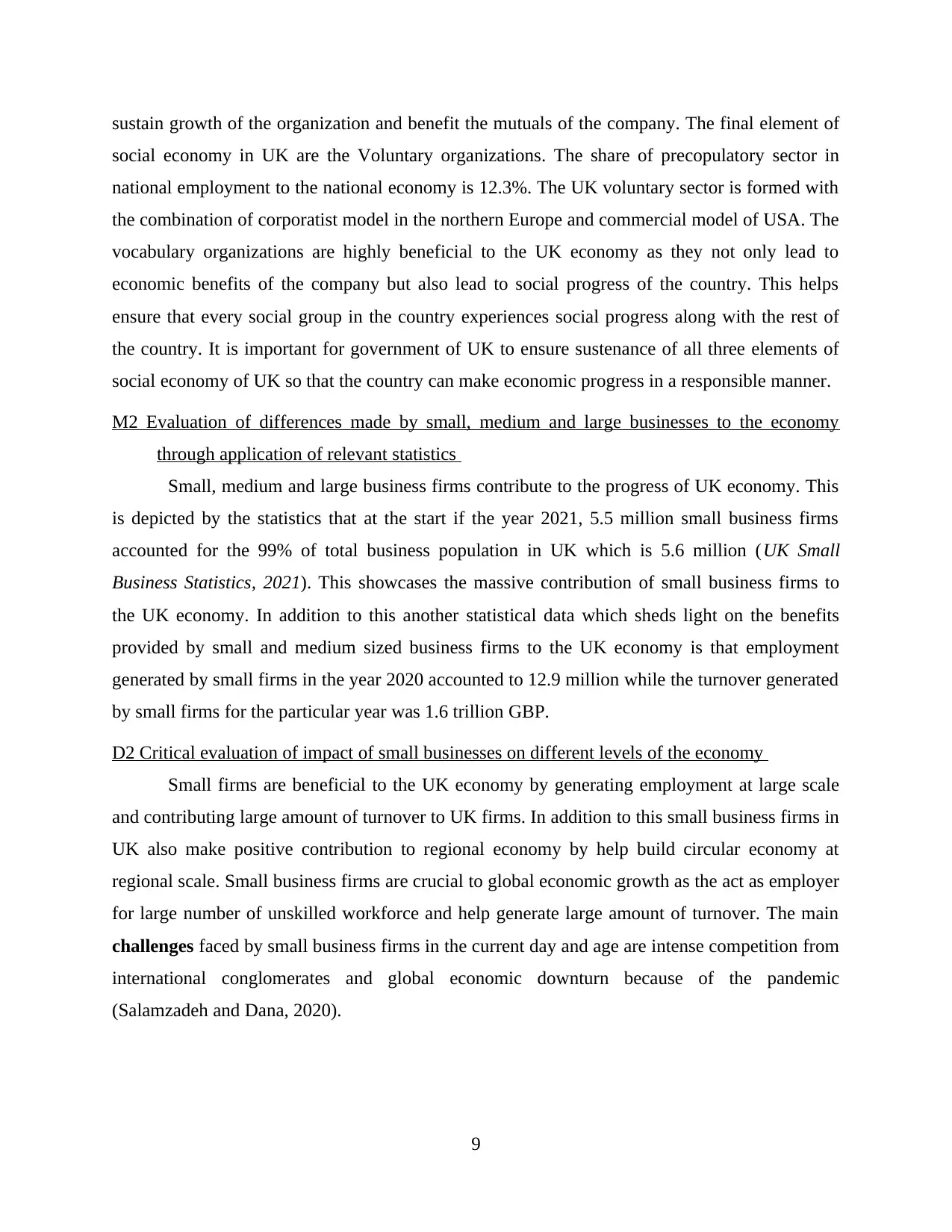
sustain growth of the organization and benefit the mutuals of the company. The final element of
social economy in UK are the Voluntary organizations. The share of precopulatory sector in
national employment to the national economy is 12.3%. The UK voluntary sector is formed with
the combination of corporatist model in the northern Europe and commercial model of USA. The
vocabulary organizations are highly beneficial to the UK economy as they not only lead to
economic benefits of the company but also lead to social progress of the country. This helps
ensure that every social group in the country experiences social progress along with the rest of
the country. It is important for government of UK to ensure sustenance of all three elements of
social economy of UK so that the country can make economic progress in a responsible manner.
M2 Evaluation of differences made by small, medium and large businesses to the economy
through application of relevant statistics
Small, medium and large business firms contribute to the progress of UK economy. This
is depicted by the statistics that at the start if the year 2021, 5.5 million small business firms
accounted for the 99% of total business population in UK which is 5.6 million (UK Small
Business Statistics, 2021). This showcases the massive contribution of small business firms to
the UK economy. In addition to this another statistical data which sheds light on the benefits
provided by small and medium sized business firms to the UK economy is that employment
generated by small firms in the year 2020 accounted to 12.9 million while the turnover generated
by small firms for the particular year was 1.6 trillion GBP.
D2 Critical evaluation of impact of small businesses on different levels of the economy
Small firms are beneficial to the UK economy by generating employment at large scale
and contributing large amount of turnover to UK firms. In addition to this small business firms in
UK also make positive contribution to regional economy by help build circular economy at
regional scale. Small business firms are crucial to global economic growth as the act as employer
for large number of unskilled workforce and help generate large amount of turnover. The main
challenges faced by small business firms in the current day and age are intense competition from
international conglomerates and global economic downturn because of the pandemic
(Salamzadeh and Dana, 2020).
9
social economy in UK are the Voluntary organizations. The share of precopulatory sector in
national employment to the national economy is 12.3%. The UK voluntary sector is formed with
the combination of corporatist model in the northern Europe and commercial model of USA. The
vocabulary organizations are highly beneficial to the UK economy as they not only lead to
economic benefits of the company but also lead to social progress of the country. This helps
ensure that every social group in the country experiences social progress along with the rest of
the country. It is important for government of UK to ensure sustenance of all three elements of
social economy of UK so that the country can make economic progress in a responsible manner.
M2 Evaluation of differences made by small, medium and large businesses to the economy
through application of relevant statistics
Small, medium and large business firms contribute to the progress of UK economy. This
is depicted by the statistics that at the start if the year 2021, 5.5 million small business firms
accounted for the 99% of total business population in UK which is 5.6 million (UK Small
Business Statistics, 2021). This showcases the massive contribution of small business firms to
the UK economy. In addition to this another statistical data which sheds light on the benefits
provided by small and medium sized business firms to the UK economy is that employment
generated by small firms in the year 2020 accounted to 12.9 million while the turnover generated
by small firms for the particular year was 1.6 trillion GBP.
D2 Critical evaluation of impact of small businesses on different levels of the economy
Small firms are beneficial to the UK economy by generating employment at large scale
and contributing large amount of turnover to UK firms. In addition to this small business firms in
UK also make positive contribution to regional economy by help build circular economy at
regional scale. Small business firms are crucial to global economic growth as the act as employer
for large number of unskilled workforce and help generate large amount of turnover. The main
challenges faced by small business firms in the current day and age are intense competition from
international conglomerates and global economic downturn because of the pandemic
(Salamzadeh and Dana, 2020).
9
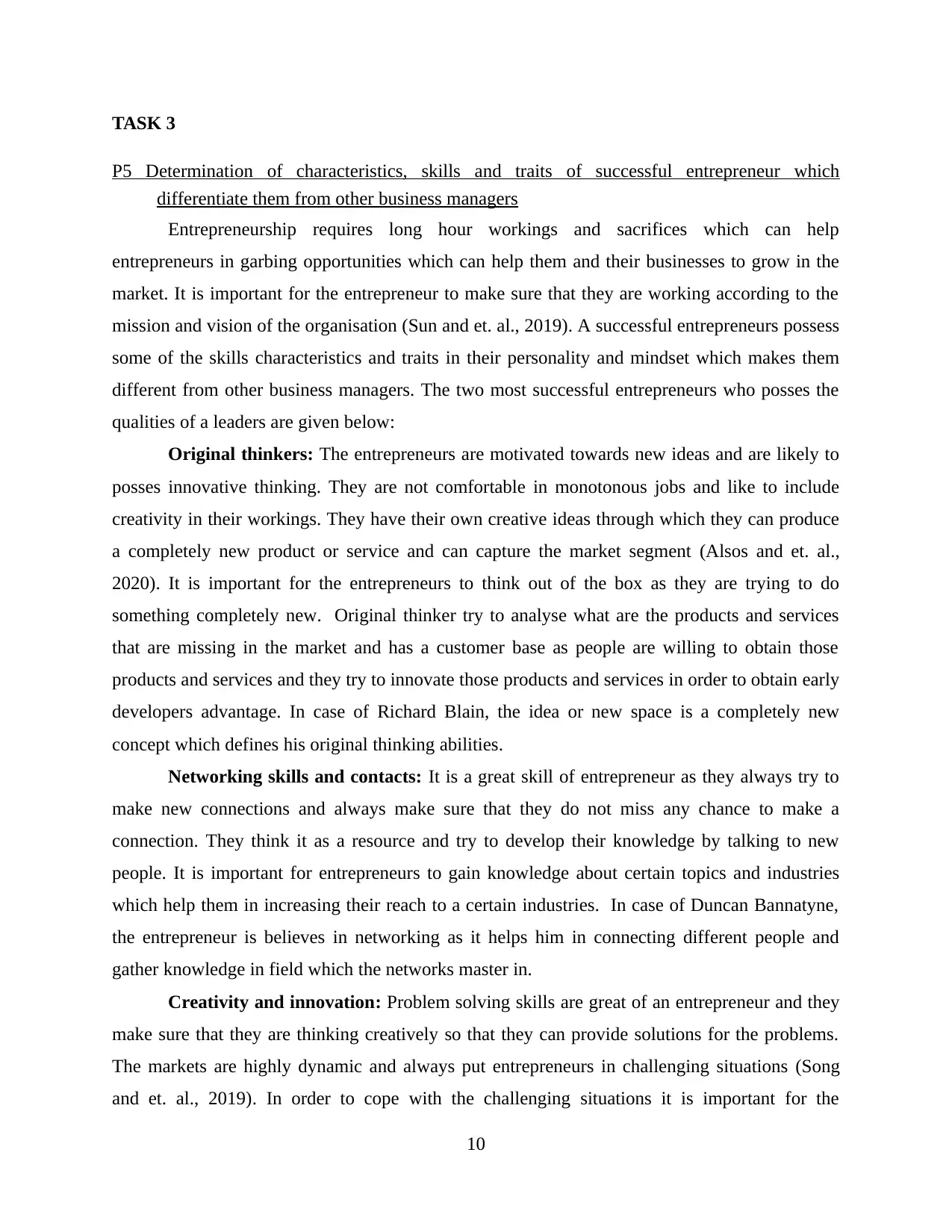
TASK 3
P5 Determination of characteristics, skills and traits of successful entrepreneur which
differentiate them from other business managers
Entrepreneurship requires long hour workings and sacrifices which can help
entrepreneurs in garbing opportunities which can help them and their businesses to grow in the
market. It is important for the entrepreneur to make sure that they are working according to the
mission and vision of the organisation (Sun and et. al., 2019). A successful entrepreneurs possess
some of the skills characteristics and traits in their personality and mindset which makes them
different from other business managers. The two most successful entrepreneurs who posses the
qualities of a leaders are given below:
Original thinkers: The entrepreneurs are motivated towards new ideas and are likely to
posses innovative thinking. They are not comfortable in monotonous jobs and like to include
creativity in their workings. They have their own creative ideas through which they can produce
a completely new product or service and can capture the market segment (Alsos and et. al.,
2020). It is important for the entrepreneurs to think out of the box as they are trying to do
something completely new. Original thinker try to analyse what are the products and services
that are missing in the market and has a customer base as people are willing to obtain those
products and services and they try to innovate those products and services in order to obtain early
developers advantage. In case of Richard Blain, the idea or new space is a completely new
concept which defines his original thinking abilities.
Networking skills and contacts: It is a great skill of entrepreneur as they always try to
make new connections and always make sure that they do not miss any chance to make a
connection. They think it as a resource and try to develop their knowledge by talking to new
people. It is important for entrepreneurs to gain knowledge about certain topics and industries
which help them in increasing their reach to a certain industries. In case of Duncan Bannatyne,
the entrepreneur is believes in networking as it helps him in connecting different people and
gather knowledge in field which the networks master in.
Creativity and innovation: Problem solving skills are great of an entrepreneur and they
make sure that they are thinking creatively so that they can provide solutions for the problems.
The markets are highly dynamic and always put entrepreneurs in challenging situations (Song
and et. al., 2019). In order to cope with the challenging situations it is important for the
10
P5 Determination of characteristics, skills and traits of successful entrepreneur which
differentiate them from other business managers
Entrepreneurship requires long hour workings and sacrifices which can help
entrepreneurs in garbing opportunities which can help them and their businesses to grow in the
market. It is important for the entrepreneur to make sure that they are working according to the
mission and vision of the organisation (Sun and et. al., 2019). A successful entrepreneurs possess
some of the skills characteristics and traits in their personality and mindset which makes them
different from other business managers. The two most successful entrepreneurs who posses the
qualities of a leaders are given below:
Original thinkers: The entrepreneurs are motivated towards new ideas and are likely to
posses innovative thinking. They are not comfortable in monotonous jobs and like to include
creativity in their workings. They have their own creative ideas through which they can produce
a completely new product or service and can capture the market segment (Alsos and et. al.,
2020). It is important for the entrepreneurs to think out of the box as they are trying to do
something completely new. Original thinker try to analyse what are the products and services
that are missing in the market and has a customer base as people are willing to obtain those
products and services and they try to innovate those products and services in order to obtain early
developers advantage. In case of Richard Blain, the idea or new space is a completely new
concept which defines his original thinking abilities.
Networking skills and contacts: It is a great skill of entrepreneur as they always try to
make new connections and always make sure that they do not miss any chance to make a
connection. They think it as a resource and try to develop their knowledge by talking to new
people. It is important for entrepreneurs to gain knowledge about certain topics and industries
which help them in increasing their reach to a certain industries. In case of Duncan Bannatyne,
the entrepreneur is believes in networking as it helps him in connecting different people and
gather knowledge in field which the networks master in.
Creativity and innovation: Problem solving skills are great of an entrepreneur and they
make sure that they are thinking creatively so that they can provide solutions for the problems.
The markets are highly dynamic and always put entrepreneurs in challenging situations (Song
and et. al., 2019). In order to cope with the challenging situations it is important for the
10
Paraphrase This Document
Need a fresh take? Get an instant paraphrase of this document with our AI Paraphraser
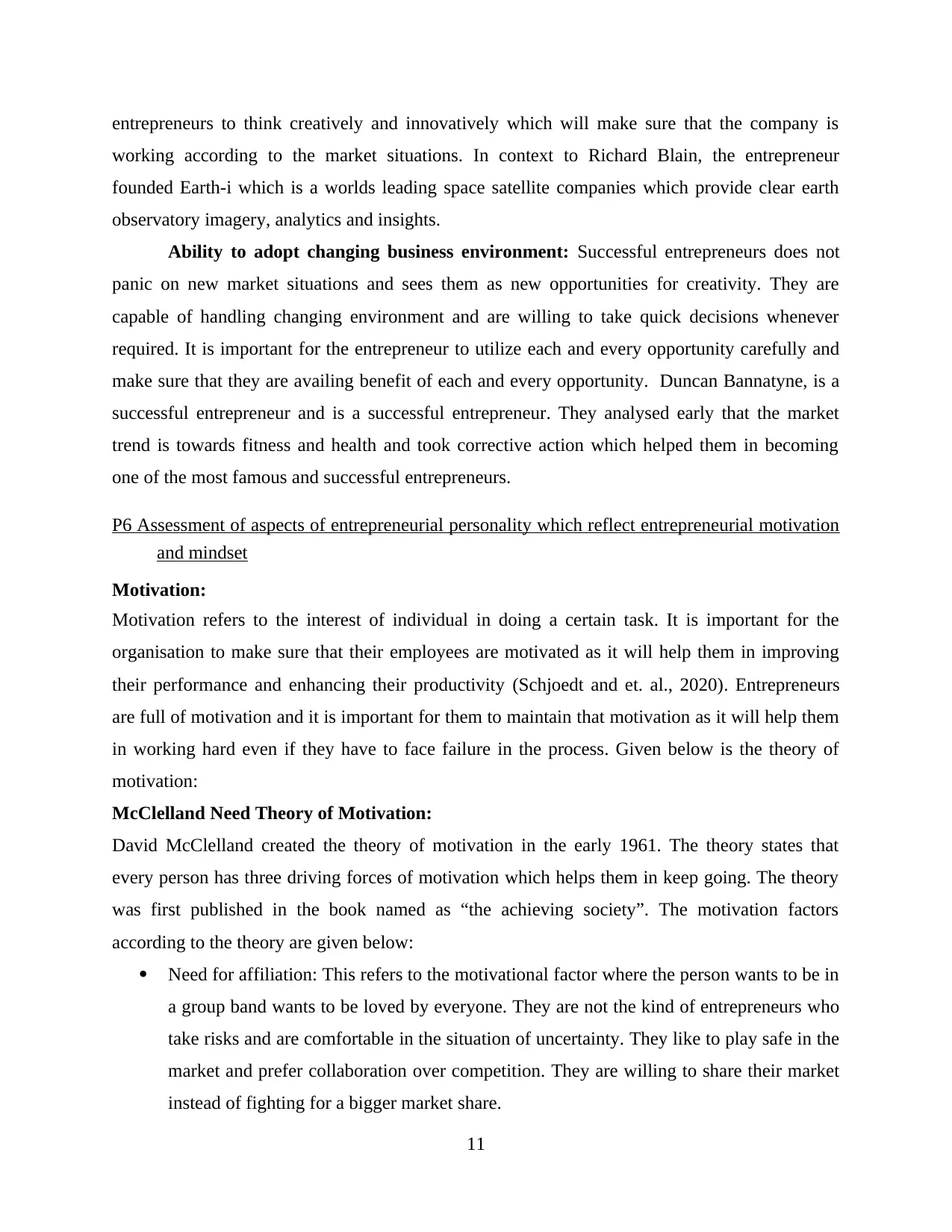
entrepreneurs to think creatively and innovatively which will make sure that the company is
working according to the market situations. In context to Richard Blain, the entrepreneur
founded Earth-i which is a worlds leading space satellite companies which provide clear earth
observatory imagery, analytics and insights.
Ability to adopt changing business environment: Successful entrepreneurs does not
panic on new market situations and sees them as new opportunities for creativity. They are
capable of handling changing environment and are willing to take quick decisions whenever
required. It is important for the entrepreneur to utilize each and every opportunity carefully and
make sure that they are availing benefit of each and every opportunity. Duncan Bannatyne, is a
successful entrepreneur and is a successful entrepreneur. They analysed early that the market
trend is towards fitness and health and took corrective action which helped them in becoming
one of the most famous and successful entrepreneurs.
P6 Assessment of aspects of entrepreneurial personality which reflect entrepreneurial motivation
and mindset
Motivation:
Motivation refers to the interest of individual in doing a certain task. It is important for the
organisation to make sure that their employees are motivated as it will help them in improving
their performance and enhancing their productivity (Schjoedt and et. al., 2020). Entrepreneurs
are full of motivation and it is important for them to maintain that motivation as it will help them
in working hard even if they have to face failure in the process. Given below is the theory of
motivation:
McClelland Need Theory of Motivation:
David McClelland created the theory of motivation in the early 1961. The theory states that
every person has three driving forces of motivation which helps them in keep going. The theory
was first published in the book named as “the achieving society”. The motivation factors
according to the theory are given below:
Need for affiliation: This refers to the motivational factor where the person wants to be in
a group band wants to be loved by everyone. They are not the kind of entrepreneurs who
take risks and are comfortable in the situation of uncertainty. They like to play safe in the
market and prefer collaboration over competition. They are willing to share their market
instead of fighting for a bigger market share.
11
working according to the market situations. In context to Richard Blain, the entrepreneur
founded Earth-i which is a worlds leading space satellite companies which provide clear earth
observatory imagery, analytics and insights.
Ability to adopt changing business environment: Successful entrepreneurs does not
panic on new market situations and sees them as new opportunities for creativity. They are
capable of handling changing environment and are willing to take quick decisions whenever
required. It is important for the entrepreneur to utilize each and every opportunity carefully and
make sure that they are availing benefit of each and every opportunity. Duncan Bannatyne, is a
successful entrepreneur and is a successful entrepreneur. They analysed early that the market
trend is towards fitness and health and took corrective action which helped them in becoming
one of the most famous and successful entrepreneurs.
P6 Assessment of aspects of entrepreneurial personality which reflect entrepreneurial motivation
and mindset
Motivation:
Motivation refers to the interest of individual in doing a certain task. It is important for the
organisation to make sure that their employees are motivated as it will help them in improving
their performance and enhancing their productivity (Schjoedt and et. al., 2020). Entrepreneurs
are full of motivation and it is important for them to maintain that motivation as it will help them
in working hard even if they have to face failure in the process. Given below is the theory of
motivation:
McClelland Need Theory of Motivation:
David McClelland created the theory of motivation in the early 1961. The theory states that
every person has three driving forces of motivation which helps them in keep going. The theory
was first published in the book named as “the achieving society”. The motivation factors
according to the theory are given below:
Need for affiliation: This refers to the motivational factor where the person wants to be in
a group band wants to be loved by everyone. They are not the kind of entrepreneurs who
take risks and are comfortable in the situation of uncertainty. They like to play safe in the
market and prefer collaboration over competition. They are willing to share their market
instead of fighting for a bigger market share.
11
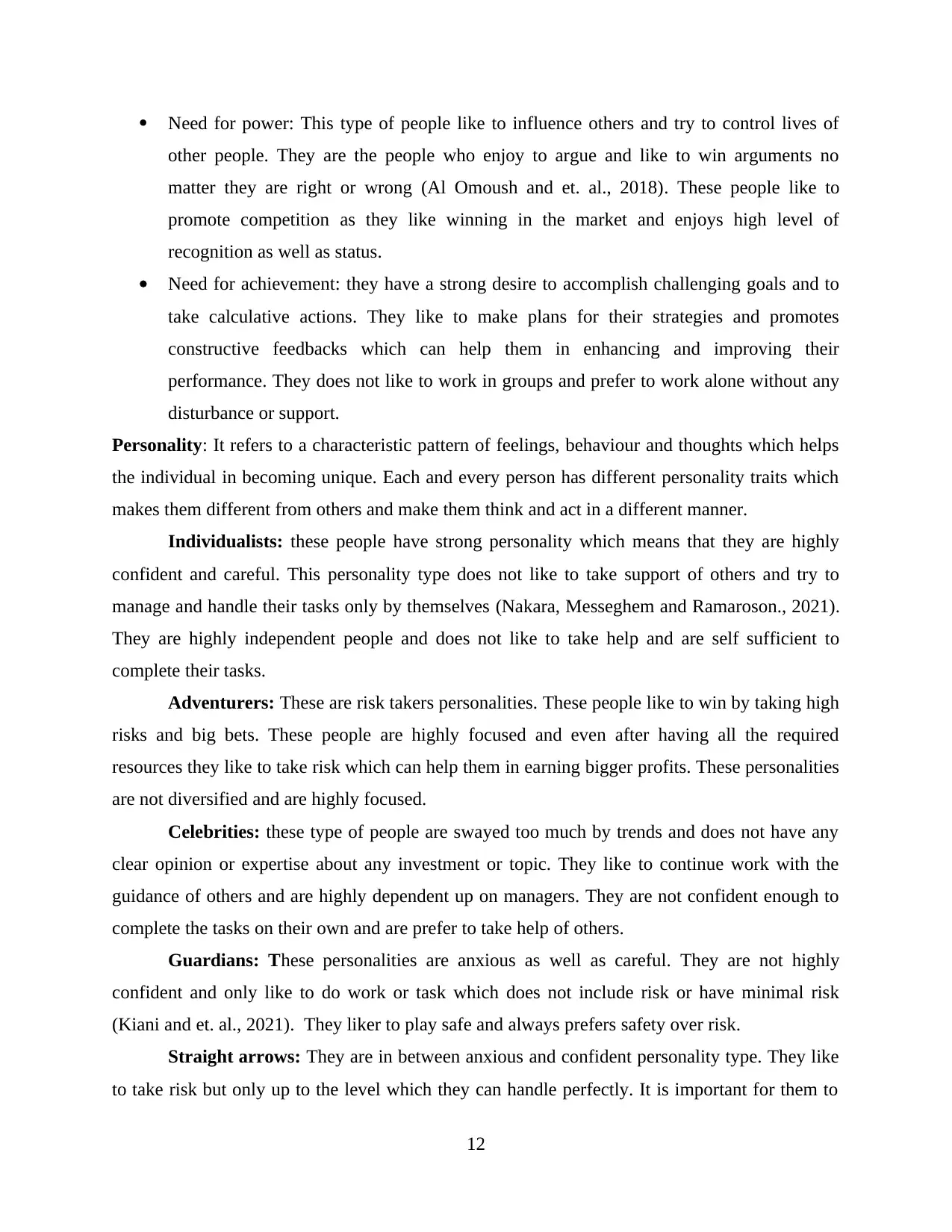
Need for power: This type of people like to influence others and try to control lives of
other people. They are the people who enjoy to argue and like to win arguments no
matter they are right or wrong (Al Omoush and et. al., 2018). These people like to
promote competition as they like winning in the market and enjoys high level of
recognition as well as status.
Need for achievement: they have a strong desire to accomplish challenging goals and to
take calculative actions. They like to make plans for their strategies and promotes
constructive feedbacks which can help them in enhancing and improving their
performance. They does not like to work in groups and prefer to work alone without any
disturbance or support.
Personality: It refers to a characteristic pattern of feelings, behaviour and thoughts which helps
the individual in becoming unique. Each and every person has different personality traits which
makes them different from others and make them think and act in a different manner.
Individualists: these people have strong personality which means that they are highly
confident and careful. This personality type does not like to take support of others and try to
manage and handle their tasks only by themselves (Nakara, Messeghem and Ramaroson., 2021).
They are highly independent people and does not like to take help and are self sufficient to
complete their tasks.
Adventurers: These are risk takers personalities. These people like to win by taking high
risks and big bets. These people are highly focused and even after having all the required
resources they like to take risk which can help them in earning bigger profits. These personalities
are not diversified and are highly focused.
Celebrities: these type of people are swayed too much by trends and does not have any
clear opinion or expertise about any investment or topic. They like to continue work with the
guidance of others and are highly dependent up on managers. They are not confident enough to
complete the tasks on their own and are prefer to take help of others.
Guardians: These personalities are anxious as well as careful. They are not highly
confident and only like to do work or task which does not include risk or have minimal risk
(Kiani and et. al., 2021). They liker to play safe and always prefers safety over risk.
Straight arrows: They are in between anxious and confident personality type. They like
to take risk but only up to the level which they can handle perfectly. It is important for them to
12
other people. They are the people who enjoy to argue and like to win arguments no
matter they are right or wrong (Al Omoush and et. al., 2018). These people like to
promote competition as they like winning in the market and enjoys high level of
recognition as well as status.
Need for achievement: they have a strong desire to accomplish challenging goals and to
take calculative actions. They like to make plans for their strategies and promotes
constructive feedbacks which can help them in enhancing and improving their
performance. They does not like to work in groups and prefer to work alone without any
disturbance or support.
Personality: It refers to a characteristic pattern of feelings, behaviour and thoughts which helps
the individual in becoming unique. Each and every person has different personality traits which
makes them different from others and make them think and act in a different manner.
Individualists: these people have strong personality which means that they are highly
confident and careful. This personality type does not like to take support of others and try to
manage and handle their tasks only by themselves (Nakara, Messeghem and Ramaroson., 2021).
They are highly independent people and does not like to take help and are self sufficient to
complete their tasks.
Adventurers: These are risk takers personalities. These people like to win by taking high
risks and big bets. These people are highly focused and even after having all the required
resources they like to take risk which can help them in earning bigger profits. These personalities
are not diversified and are highly focused.
Celebrities: these type of people are swayed too much by trends and does not have any
clear opinion or expertise about any investment or topic. They like to continue work with the
guidance of others and are highly dependent up on managers. They are not confident enough to
complete the tasks on their own and are prefer to take help of others.
Guardians: These personalities are anxious as well as careful. They are not highly
confident and only like to do work or task which does not include risk or have minimal risk
(Kiani and et. al., 2021). They liker to play safe and always prefers safety over risk.
Straight arrows: They are in between anxious and confident personality type. They like
to take risk but only up to the level which they can handle perfectly. It is important for them to
12
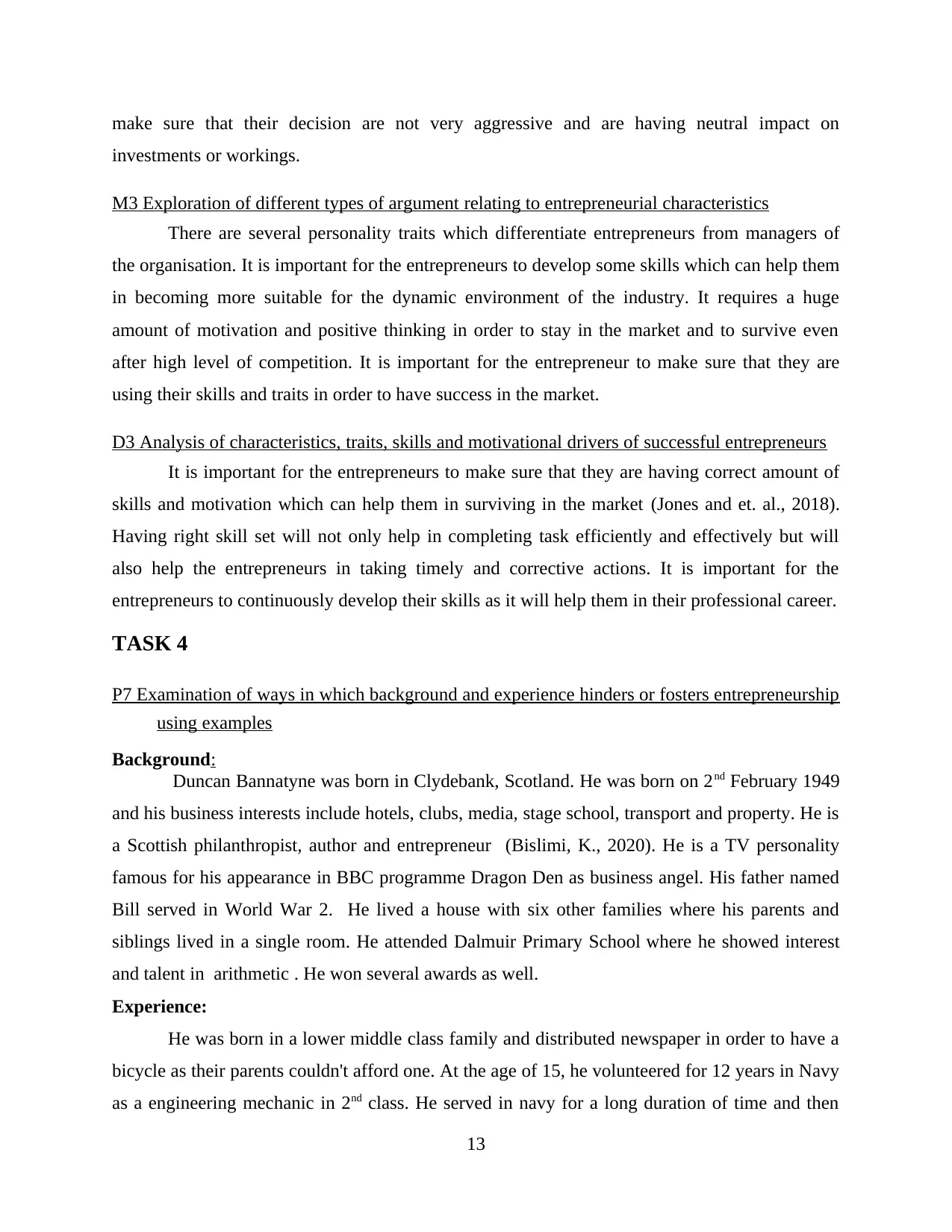
make sure that their decision are not very aggressive and are having neutral impact on
investments or workings.
M3 Exploration of different types of argument relating to entrepreneurial characteristics
There are several personality traits which differentiate entrepreneurs from managers of
the organisation. It is important for the entrepreneurs to develop some skills which can help them
in becoming more suitable for the dynamic environment of the industry. It requires a huge
amount of motivation and positive thinking in order to stay in the market and to survive even
after high level of competition. It is important for the entrepreneur to make sure that they are
using their skills and traits in order to have success in the market.
D3 Analysis of characteristics, traits, skills and motivational drivers of successful entrepreneurs
It is important for the entrepreneurs to make sure that they are having correct amount of
skills and motivation which can help them in surviving in the market (Jones and et. al., 2018).
Having right skill set will not only help in completing task efficiently and effectively but will
also help the entrepreneurs in taking timely and corrective actions. It is important for the
entrepreneurs to continuously develop their skills as it will help them in their professional career.
TASK 4
P7 Examination of ways in which background and experience hinders or fosters entrepreneurship
using examples
Background:
Duncan Bannatyne was born in Clydebank, Scotland. He was born on 2nd February 1949
and his business interests include hotels, clubs, media, stage school, transport and property. He is
a Scottish philanthropist, author and entrepreneur (Bislimi, K., 2020). He is a TV personality
famous for his appearance in BBC programme Dragon Den as business angel. His father named
Bill served in World War 2. He lived a house with six other families where his parents and
siblings lived in a single room. He attended Dalmuir Primary School where he showed interest
and talent in arithmetic . He won several awards as well.
Experience:
He was born in a lower middle class family and distributed newspaper in order to have a
bicycle as their parents couldn't afford one. At the age of 15, he volunteered for 12 years in Navy
as a engineering mechanic in 2nd class. He served in navy for a long duration of time and then
13
investments or workings.
M3 Exploration of different types of argument relating to entrepreneurial characteristics
There are several personality traits which differentiate entrepreneurs from managers of
the organisation. It is important for the entrepreneurs to develop some skills which can help them
in becoming more suitable for the dynamic environment of the industry. It requires a huge
amount of motivation and positive thinking in order to stay in the market and to survive even
after high level of competition. It is important for the entrepreneur to make sure that they are
using their skills and traits in order to have success in the market.
D3 Analysis of characteristics, traits, skills and motivational drivers of successful entrepreneurs
It is important for the entrepreneurs to make sure that they are having correct amount of
skills and motivation which can help them in surviving in the market (Jones and et. al., 2018).
Having right skill set will not only help in completing task efficiently and effectively but will
also help the entrepreneurs in taking timely and corrective actions. It is important for the
entrepreneurs to continuously develop their skills as it will help them in their professional career.
TASK 4
P7 Examination of ways in which background and experience hinders or fosters entrepreneurship
using examples
Background:
Duncan Bannatyne was born in Clydebank, Scotland. He was born on 2nd February 1949
and his business interests include hotels, clubs, media, stage school, transport and property. He is
a Scottish philanthropist, author and entrepreneur (Bislimi, K., 2020). He is a TV personality
famous for his appearance in BBC programme Dragon Den as business angel. His father named
Bill served in World War 2. He lived a house with six other families where his parents and
siblings lived in a single room. He attended Dalmuir Primary School where he showed interest
and talent in arithmetic . He won several awards as well.
Experience:
He was born in a lower middle class family and distributed newspaper in order to have a
bicycle as their parents couldn't afford one. At the age of 15, he volunteered for 12 years in Navy
as a engineering mechanic in 2nd class. He served in navy for a long duration of time and then
13
Secure Best Marks with AI Grader
Need help grading? Try our AI Grader for instant feedback on your assignments.
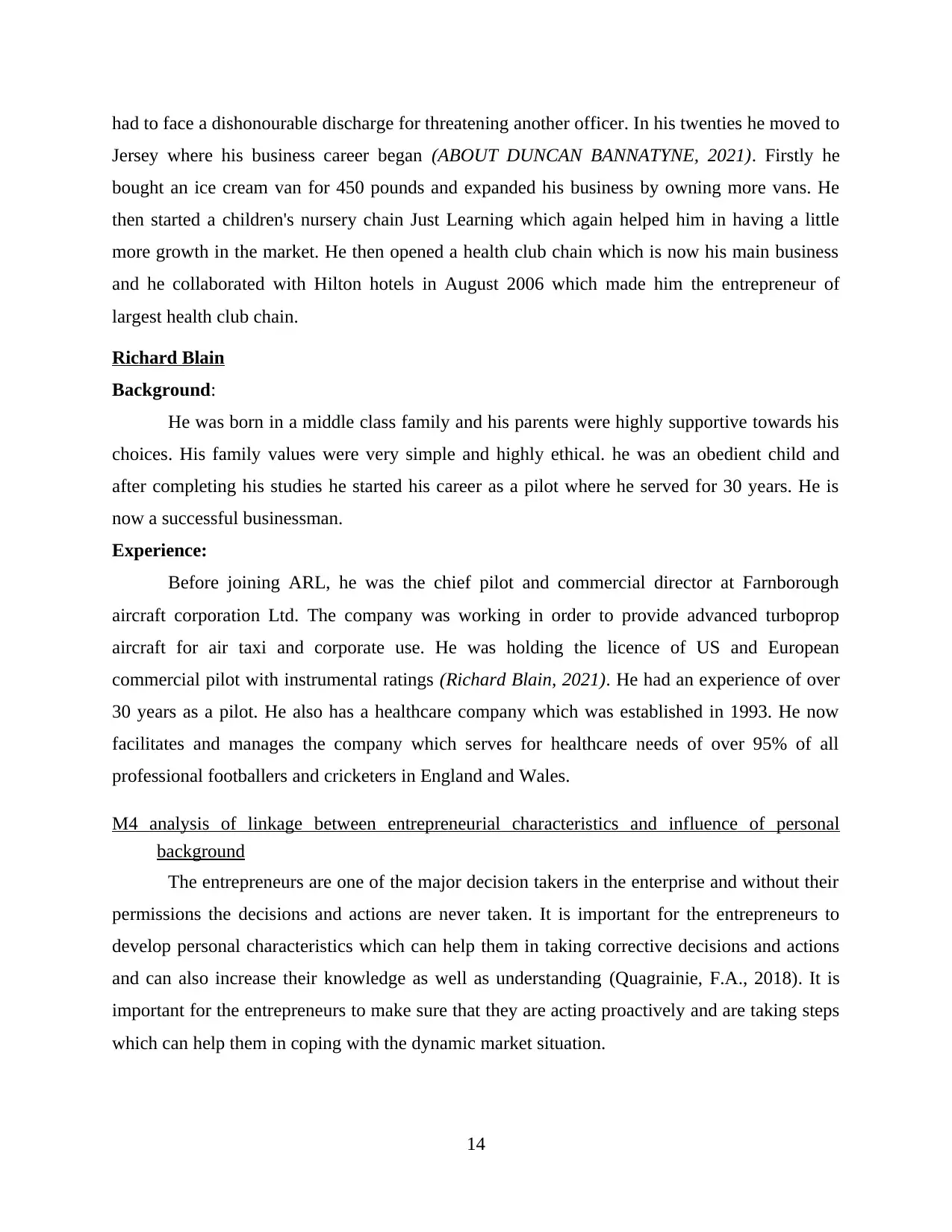
had to face a dishonourable discharge for threatening another officer. In his twenties he moved to
Jersey where his business career began (ABOUT DUNCAN BANNATYNE, 2021). Firstly he
bought an ice cream van for 450 pounds and expanded his business by owning more vans. He
then started a children's nursery chain Just Learning which again helped him in having a little
more growth in the market. He then opened a health club chain which is now his main business
and he collaborated with Hilton hotels in August 2006 which made him the entrepreneur of
largest health club chain.
Richard Blain
Background:
He was born in a middle class family and his parents were highly supportive towards his
choices. His family values were very simple and highly ethical. he was an obedient child and
after completing his studies he started his career as a pilot where he served for 30 years. He is
now a successful businessman.
Experience:
Before joining ARL, he was the chief pilot and commercial director at Farnborough
aircraft corporation Ltd. The company was working in order to provide advanced turboprop
aircraft for air taxi and corporate use. He was holding the licence of US and European
commercial pilot with instrumental ratings (Richard Blain, 2021). He had an experience of over
30 years as a pilot. He also has a healthcare company which was established in 1993. He now
facilitates and manages the company which serves for healthcare needs of over 95% of all
professional footballers and cricketers in England and Wales.
M4 analysis of linkage between entrepreneurial characteristics and influence of personal
background
The entrepreneurs are one of the major decision takers in the enterprise and without their
permissions the decisions and actions are never taken. It is important for the entrepreneurs to
develop personal characteristics which can help them in taking corrective decisions and actions
and can also increase their knowledge as well as understanding (Quagrainie, F.A., 2018). It is
important for the entrepreneurs to make sure that they are acting proactively and are taking steps
which can help them in coping with the dynamic market situation.
14
Jersey where his business career began (ABOUT DUNCAN BANNATYNE, 2021). Firstly he
bought an ice cream van for 450 pounds and expanded his business by owning more vans. He
then started a children's nursery chain Just Learning which again helped him in having a little
more growth in the market. He then opened a health club chain which is now his main business
and he collaborated with Hilton hotels in August 2006 which made him the entrepreneur of
largest health club chain.
Richard Blain
Background:
He was born in a middle class family and his parents were highly supportive towards his
choices. His family values were very simple and highly ethical. he was an obedient child and
after completing his studies he started his career as a pilot where he served for 30 years. He is
now a successful businessman.
Experience:
Before joining ARL, he was the chief pilot and commercial director at Farnborough
aircraft corporation Ltd. The company was working in order to provide advanced turboprop
aircraft for air taxi and corporate use. He was holding the licence of US and European
commercial pilot with instrumental ratings (Richard Blain, 2021). He had an experience of over
30 years as a pilot. He also has a healthcare company which was established in 1993. He now
facilitates and manages the company which serves for healthcare needs of over 95% of all
professional footballers and cricketers in England and Wales.
M4 analysis of linkage between entrepreneurial characteristics and influence of personal
background
The entrepreneurs are one of the major decision takers in the enterprise and without their
permissions the decisions and actions are never taken. It is important for the entrepreneurs to
develop personal characteristics which can help them in taking corrective decisions and actions
and can also increase their knowledge as well as understanding (Quagrainie, F.A., 2018). It is
important for the entrepreneurs to make sure that they are acting proactively and are taking steps
which can help them in coping with the dynamic market situation.
14
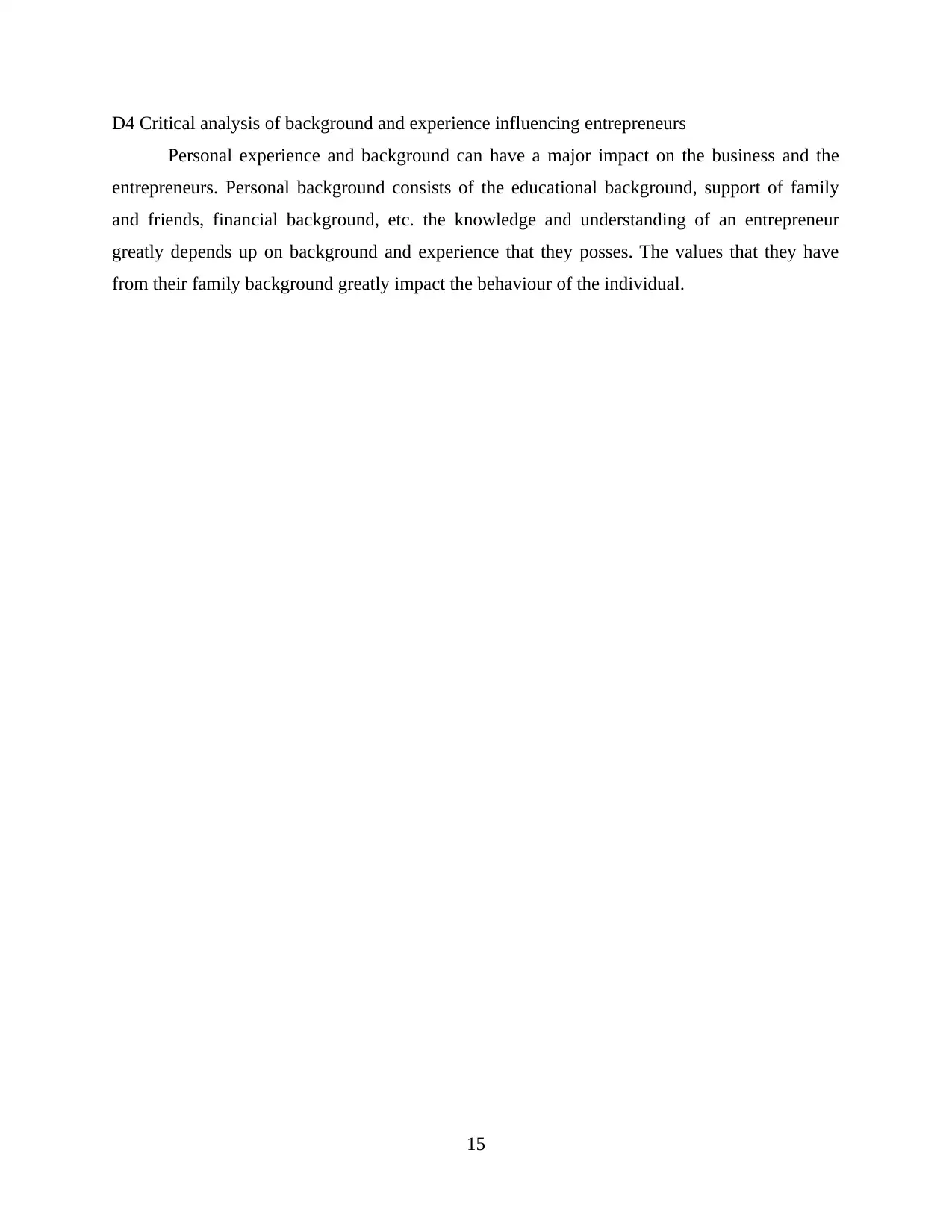
D4 Critical analysis of background and experience influencing entrepreneurs
Personal experience and background can have a major impact on the business and the
entrepreneurs. Personal background consists of the educational background, support of family
and friends, financial background, etc. the knowledge and understanding of an entrepreneur
greatly depends up on background and experience that they posses. The values that they have
from their family background greatly impact the behaviour of the individual.
15
Personal experience and background can have a major impact on the business and the
entrepreneurs. Personal background consists of the educational background, support of family
and friends, financial background, etc. the knowledge and understanding of an entrepreneur
greatly depends up on background and experience that they posses. The values that they have
from their family background greatly impact the behaviour of the individual.
15
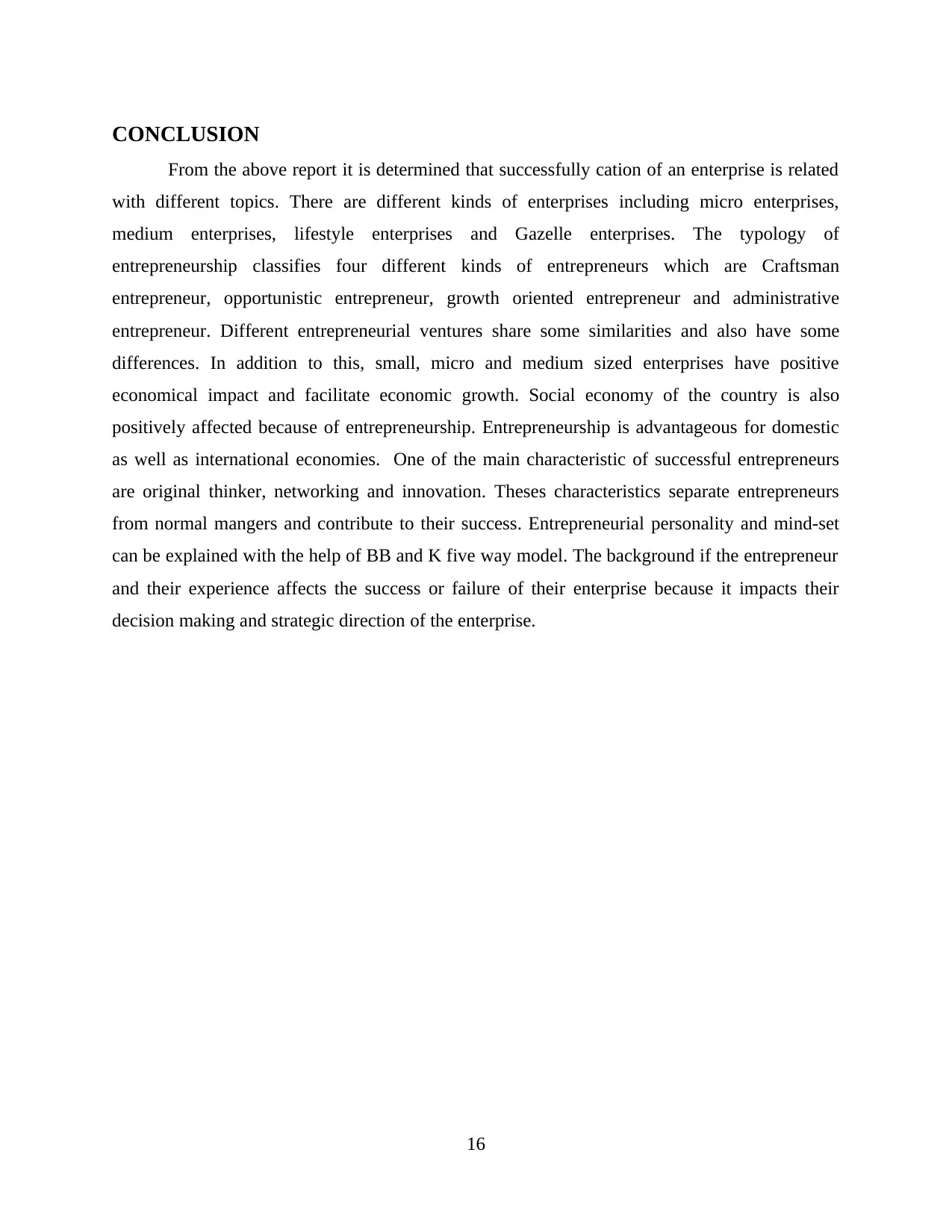
CONCLUSION
From the above report it is determined that successfully cation of an enterprise is related
with different topics. There are different kinds of enterprises including micro enterprises,
medium enterprises, lifestyle enterprises and Gazelle enterprises. The typology of
entrepreneurship classifies four different kinds of entrepreneurs which are Craftsman
entrepreneur, opportunistic entrepreneur, growth oriented entrepreneur and administrative
entrepreneur. Different entrepreneurial ventures share some similarities and also have some
differences. In addition to this, small, micro and medium sized enterprises have positive
economical impact and facilitate economic growth. Social economy of the country is also
positively affected because of entrepreneurship. Entrepreneurship is advantageous for domestic
as well as international economies. One of the main characteristic of successful entrepreneurs
are original thinker, networking and innovation. Theses characteristics separate entrepreneurs
from normal mangers and contribute to their success. Entrepreneurial personality and mind-set
can be explained with the help of BB and K five way model. The background if the entrepreneur
and their experience affects the success or failure of their enterprise because it impacts their
decision making and strategic direction of the enterprise.
16
From the above report it is determined that successfully cation of an enterprise is related
with different topics. There are different kinds of enterprises including micro enterprises,
medium enterprises, lifestyle enterprises and Gazelle enterprises. The typology of
entrepreneurship classifies four different kinds of entrepreneurs which are Craftsman
entrepreneur, opportunistic entrepreneur, growth oriented entrepreneur and administrative
entrepreneur. Different entrepreneurial ventures share some similarities and also have some
differences. In addition to this, small, micro and medium sized enterprises have positive
economical impact and facilitate economic growth. Social economy of the country is also
positively affected because of entrepreneurship. Entrepreneurship is advantageous for domestic
as well as international economies. One of the main characteristic of successful entrepreneurs
are original thinker, networking and innovation. Theses characteristics separate entrepreneurs
from normal mangers and contribute to their success. Entrepreneurial personality and mind-set
can be explained with the help of BB and K five way model. The background if the entrepreneur
and their experience affects the success or failure of their enterprise because it impacts their
decision making and strategic direction of the enterprise.
16
Paraphrase This Document
Need a fresh take? Get an instant paraphrase of this document with our AI Paraphraser
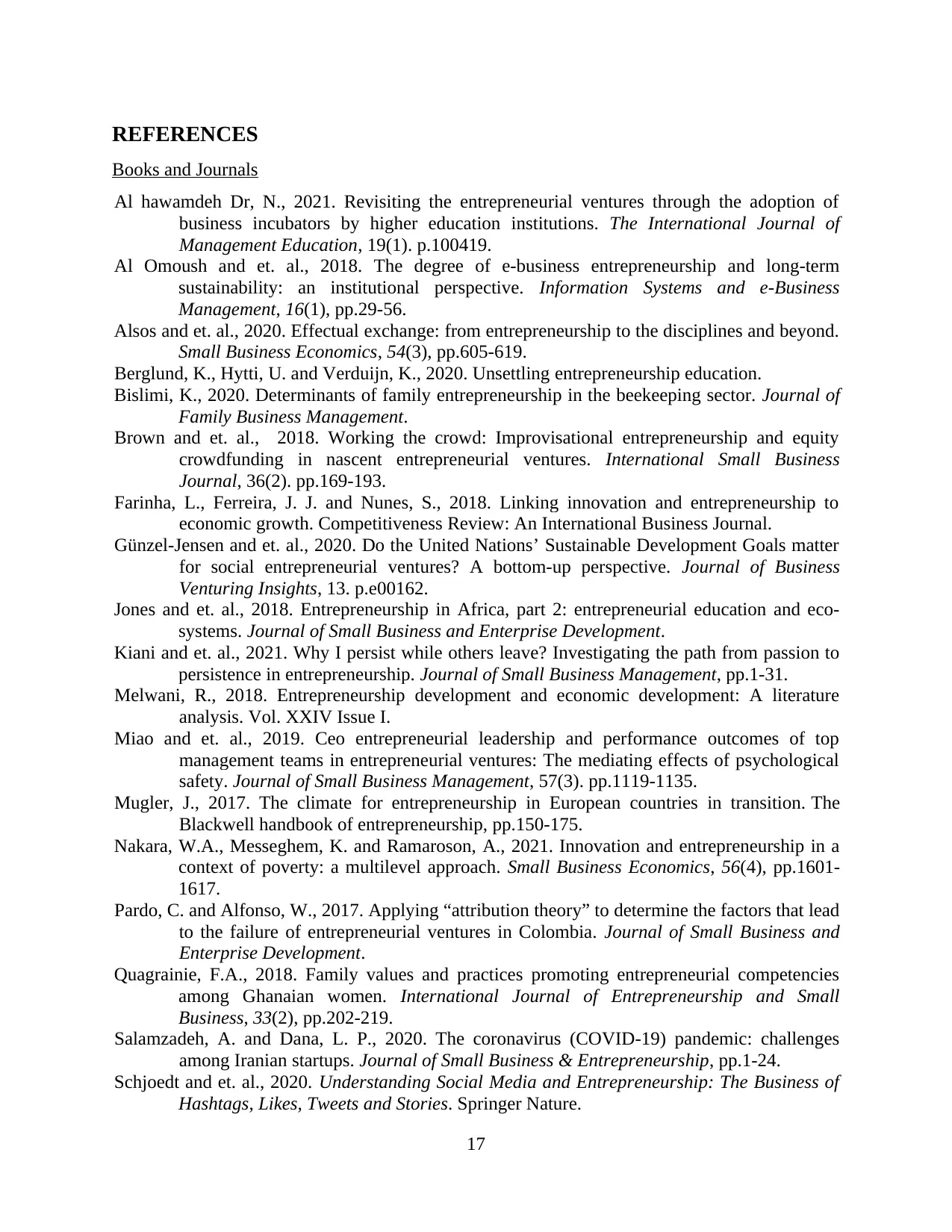
REFERENCES
Books and Journals
Al hawamdeh Dr, N., 2021. Revisiting the entrepreneurial ventures through the adoption of
business incubators by higher education institutions. The International Journal of
Management Education, 19(1). p.100419.
Al Omoush and et. al., 2018. The degree of e-business entrepreneurship and long-term
sustainability: an institutional perspective. Information Systems and e-Business
Management, 16(1), pp.29-56.
Alsos and et. al., 2020. Effectual exchange: from entrepreneurship to the disciplines and beyond.
Small Business Economics, 54(3), pp.605-619.
Berglund, K., Hytti, U. and Verduijn, K., 2020. Unsettling entrepreneurship education.
Bislimi, K., 2020. Determinants of family entrepreneurship in the beekeeping sector. Journal of
Family Business Management.
Brown and et. al., 2018. Working the crowd: Improvisational entrepreneurship and equity
crowdfunding in nascent entrepreneurial ventures. International Small Business
Journal, 36(2). pp.169-193.
Farinha, L., Ferreira, J. J. and Nunes, S., 2018. Linking innovation and entrepreneurship to
economic growth. Competitiveness Review: An International Business Journal.
Günzel-Jensen and et. al., 2020. Do the United Nations’ Sustainable Development Goals matter
for social entrepreneurial ventures? A bottom-up perspective. Journal of Business
Venturing Insights, 13. p.e00162.
Jones and et. al., 2018. Entrepreneurship in Africa, part 2: entrepreneurial education and eco-
systems. Journal of Small Business and Enterprise Development.
Kiani and et. al., 2021. Why I persist while others leave? Investigating the path from passion to
persistence in entrepreneurship. Journal of Small Business Management, pp.1-31.
Melwani, R., 2018. Entrepreneurship development and economic development: A literature
analysis. Vol. XXIV Issue I.
Miao and et. al., 2019. Ceo entrepreneurial leadership and performance outcomes of top
management teams in entrepreneurial ventures: The mediating effects of psychological
safety. Journal of Small Business Management, 57(3). pp.1119-1135.
Mugler, J., 2017. The climate for entrepreneurship in European countries in transition. The
Blackwell handbook of entrepreneurship, pp.150-175.
Nakara, W.A., Messeghem, K. and Ramaroson, A., 2021. Innovation and entrepreneurship in a
context of poverty: a multilevel approach. Small Business Economics, 56(4), pp.1601-
1617.
Pardo, C. and Alfonso, W., 2017. Applying “attribution theory” to determine the factors that lead
to the failure of entrepreneurial ventures in Colombia. Journal of Small Business and
Enterprise Development.
Quagrainie, F.A., 2018. Family values and practices promoting entrepreneurial competencies
among Ghanaian women. International Journal of Entrepreneurship and Small
Business, 33(2), pp.202-219.
Salamzadeh, A. and Dana, L. P., 2020. The coronavirus (COVID-19) pandemic: challenges
among Iranian startups. Journal of Small Business & Entrepreneurship, pp.1-24.
Schjoedt and et. al., 2020. Understanding Social Media and Entrepreneurship: The Business of
Hashtags, Likes, Tweets and Stories. Springer Nature.
17
Books and Journals
Al hawamdeh Dr, N., 2021. Revisiting the entrepreneurial ventures through the adoption of
business incubators by higher education institutions. The International Journal of
Management Education, 19(1). p.100419.
Al Omoush and et. al., 2018. The degree of e-business entrepreneurship and long-term
sustainability: an institutional perspective. Information Systems and e-Business
Management, 16(1), pp.29-56.
Alsos and et. al., 2020. Effectual exchange: from entrepreneurship to the disciplines and beyond.
Small Business Economics, 54(3), pp.605-619.
Berglund, K., Hytti, U. and Verduijn, K., 2020. Unsettling entrepreneurship education.
Bislimi, K., 2020. Determinants of family entrepreneurship in the beekeeping sector. Journal of
Family Business Management.
Brown and et. al., 2018. Working the crowd: Improvisational entrepreneurship and equity
crowdfunding in nascent entrepreneurial ventures. International Small Business
Journal, 36(2). pp.169-193.
Farinha, L., Ferreira, J. J. and Nunes, S., 2018. Linking innovation and entrepreneurship to
economic growth. Competitiveness Review: An International Business Journal.
Günzel-Jensen and et. al., 2020. Do the United Nations’ Sustainable Development Goals matter
for social entrepreneurial ventures? A bottom-up perspective. Journal of Business
Venturing Insights, 13. p.e00162.
Jones and et. al., 2018. Entrepreneurship in Africa, part 2: entrepreneurial education and eco-
systems. Journal of Small Business and Enterprise Development.
Kiani and et. al., 2021. Why I persist while others leave? Investigating the path from passion to
persistence in entrepreneurship. Journal of Small Business Management, pp.1-31.
Melwani, R., 2018. Entrepreneurship development and economic development: A literature
analysis. Vol. XXIV Issue I.
Miao and et. al., 2019. Ceo entrepreneurial leadership and performance outcomes of top
management teams in entrepreneurial ventures: The mediating effects of psychological
safety. Journal of Small Business Management, 57(3). pp.1119-1135.
Mugler, J., 2017. The climate for entrepreneurship in European countries in transition. The
Blackwell handbook of entrepreneurship, pp.150-175.
Nakara, W.A., Messeghem, K. and Ramaroson, A., 2021. Innovation and entrepreneurship in a
context of poverty: a multilevel approach. Small Business Economics, 56(4), pp.1601-
1617.
Pardo, C. and Alfonso, W., 2017. Applying “attribution theory” to determine the factors that lead
to the failure of entrepreneurial ventures in Colombia. Journal of Small Business and
Enterprise Development.
Quagrainie, F.A., 2018. Family values and practices promoting entrepreneurial competencies
among Ghanaian women. International Journal of Entrepreneurship and Small
Business, 33(2), pp.202-219.
Salamzadeh, A. and Dana, L. P., 2020. The coronavirus (COVID-19) pandemic: challenges
among Iranian startups. Journal of Small Business & Entrepreneurship, pp.1-24.
Schjoedt and et. al., 2020. Understanding Social Media and Entrepreneurship: The Business of
Hashtags, Likes, Tweets and Stories. Springer Nature.
17
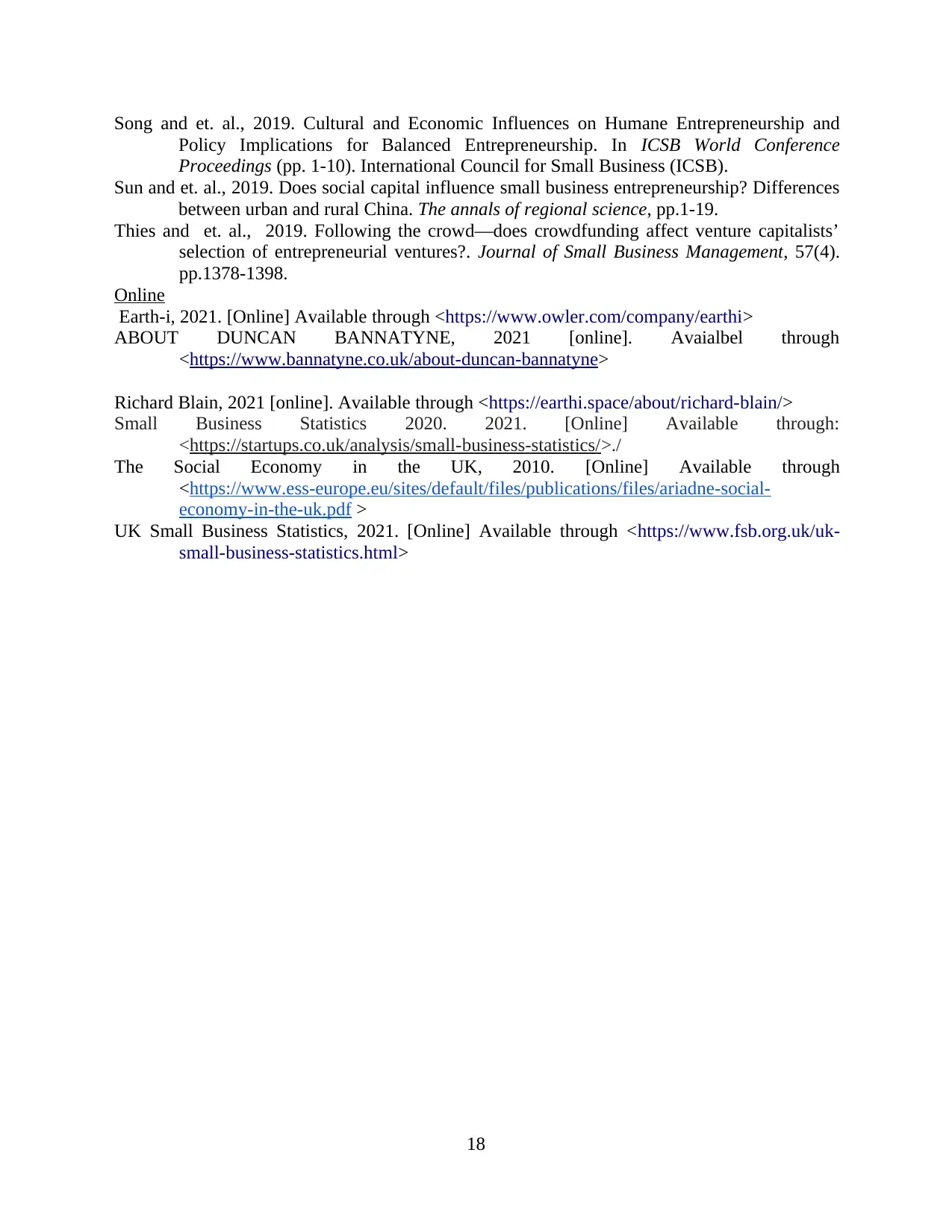
Song and et. al., 2019. Cultural and Economic Influences on Humane Entrepreneurship and
Policy Implications for Balanced Entrepreneurship. In ICSB World Conference
Proceedings (pp. 1-10). International Council for Small Business (ICSB).
Sun and et. al., 2019. Does social capital influence small business entrepreneurship? Differences
between urban and rural China. The annals of regional science, pp.1-19.
Thies and et. al., 2019. Following the crowd—does crowdfunding affect venture capitalists’
selection of entrepreneurial ventures?. Journal of Small Business Management, 57(4).
pp.1378-1398.
Online
Earth-i, 2021. [Online] Available through <https://www.owler.com/company/earthi>
ABOUT DUNCAN BANNATYNE, 2021 [online]. Avaialbel through
<https://www.bannatyne.co.uk/about-duncan-bannatyne>
Richard Blain, 2021 [online]. Available through <https://earthi.space/about/richard-blain/>
Small Business Statistics 2020. 2021. [Online] Available through:
<https://startups.co.uk/analysis/small-business-statistics/>./
The Social Economy in the UK, 2010. [Online] Available through
<https://www.ess-europe.eu/sites/default/files/publications/files/ariadne-social-
economy-in-the-uk.pdf >
UK Small Business Statistics, 2021. [Online] Available through <https://www.fsb.org.uk/uk-
small-business-statistics.html>
18
Policy Implications for Balanced Entrepreneurship. In ICSB World Conference
Proceedings (pp. 1-10). International Council for Small Business (ICSB).
Sun and et. al., 2019. Does social capital influence small business entrepreneurship? Differences
between urban and rural China. The annals of regional science, pp.1-19.
Thies and et. al., 2019. Following the crowd—does crowdfunding affect venture capitalists’
selection of entrepreneurial ventures?. Journal of Small Business Management, 57(4).
pp.1378-1398.
Online
Earth-i, 2021. [Online] Available through <https://www.owler.com/company/earthi>
ABOUT DUNCAN BANNATYNE, 2021 [online]. Avaialbel through
<https://www.bannatyne.co.uk/about-duncan-bannatyne>
Richard Blain, 2021 [online]. Available through <https://earthi.space/about/richard-blain/>
Small Business Statistics 2020. 2021. [Online] Available through:
<https://startups.co.uk/analysis/small-business-statistics/>./
The Social Economy in the UK, 2010. [Online] Available through
<https://www.ess-europe.eu/sites/default/files/publications/files/ariadne-social-
economy-in-the-uk.pdf >
UK Small Business Statistics, 2021. [Online] Available through <https://www.fsb.org.uk/uk-
small-business-statistics.html>
18
1 out of 21
Related Documents
Your All-in-One AI-Powered Toolkit for Academic Success.
+13062052269
info@desklib.com
Available 24*7 on WhatsApp / Email
![[object Object]](/_next/static/media/star-bottom.7253800d.svg)
Unlock your academic potential
© 2024 | Zucol Services PVT LTD | All rights reserved.





